Conjugal Visits
Why they’re disappearing, which states still use them, and what really happens during those overnight visits..
Although conjugal, or “extended,” visits play a huge role in prison lore, in reality, very few inmates have access to them. Twenty years ago, 17 states offered these programs. Today, just four do: California, Connecticut, New York, and Washington. No federal prison offers extended, private visitation.
Last April, New Mexico became the latest state to cancel conjugal visits for prisoners after a local television station revealed that a convicted killer, Michael Guzman, had fathered four children with several different wives while in prison. Mississippi had made a similar decision in January 2014.
A Stay at the “Boneyard”
In every state that offers extended visits, good prison behavior is a prerequisite, and inmates convicted of sex crimes or domestic violence, or who have life sentences, are typically excluded.
The visits range from one hour to three days, and happen as often as once per month. They take place in trailers, small apartments, or “family cottages” built just for this purpose, and are sometimes referred to as “ boneyards .” At the MacDougall-Walker Correctional Institution in Connecticut, units are set up to imitate homes. Each apartment has two bedrooms, a dining room, and a living room with a TV, DVD player, playing cards, a Jenga game, and dominoes. In Washington, any DVD a family watches must be G-rated. Kitchens are typically fully functional, and visitors can bring in fresh ingredients or cooked food from the outside.
In California, inmates and their visitors must line up for inspection every four hours throughout the weekend visit, even in the middle of the night. Many prisons provide condoms for free. In New Mexico, before the extended visitation program was canceled, the prisoner’s spouse could be informed if the inmate had tested positive for a sexually transmitted infection. After the visit, both inmates and visitors are searched, and inmates typically have their urine tested to check for drugs or alcohol, which are strictly prohibited.
What Everyone Gets Wrong
Conjugal visits are not just about sex. In fact, they are officially called “family visits,” and kids are allowed to stay overnight, too. In Connecticut, a spouse or partner can’t come alone: the child of the inmate must be present. In Washington, two related inmates at the same facility, such as siblings or a father and son, are allowed to arrange a joint visit with family members from the outside. Only about a third of extended visits in the state take place between spouses alone.
The Insider’s Perspective
Serena L. was an inmate at the Bedford Hills Correctional Facility in New York from 1999 to 2002. During that time, she qualified for just one overnight trailer visit. Her 15-year-old sister, who lived on Long Island, persuaded a friend to drive her to the prison. “I remember her coming through the gate, carrying two big bags of food, and she said, ‘I got your favorite: Oreos!’ ” Serena says. “It was like a little slumber party for us. When I was first incarcerated, we had tried to write to each other and talk to each other by phone, but there was lots we weren’t really emotionally able to come to terms with until we had that private space, without a CO watching, to do it.”
The (Checkered) History
Conjugal visits began around 1918 at Parchman Farm, a labor camp in Mississippi. At first, the visits were for black prisoners only, and the visitors were local prostitutes, who arrived on Sundays and were paid to service both married and single inmates. According to historian David Oshinsky, Jim Crow-era prison officials believed African-American men had stronger sex drives than whites, and would not work as hard in the cotton fields if they were not sexually sated. The program expanded in the 1940s to include white, male inmates and their wives, and in the 1970s to include female inmates.
Has your partner been in prison? Help others understand what the experience is like by filling out our questionnaire.

Our reporting has real impact on the criminal justice system

Our journalism establishes facts, exposes failures and examines solutions for a criminal justice system in crisis. If you believe in what we do, become a member today.
Stay up to date on our reporting and analysis.
Controversy and Conjugal Visits
Conjugal visits were first allowed as incentives for the forced labor of incarcerated Black men, the practice expanding from there. Is human touch a right?

“The words ‘conjugal visit’ seem to have a dirty ring to them for a lot of people,” a man named John Stefanisko wrote for The Bridge, a quarterly at the Connecticut Correctional Institution at Somers, in December 1963 . This observation marked the beginning of a long campaign—far longer, perhaps, than the men at Somers could have anticipated—for conjugal visits in the state of Connecticut, a policy that would grant many incarcerated men the privilege of having sex with their wives. Conjugal visits, the editors of The Bridge wrote, are “a controversial issue, now quite in the spotlight,” thanks to their implementation at Parchman Farm in Mississippi in 1965. But the urgency of the mens’ plea, as chronicled in The Bridge and the Somers Weekly Scene , gives voice to the depth of their deprivation. “Perhaps we’re whistling in the wind,” they wrote, “but if the truth hits home to only a few, we’ll be satisfied.”

The men at Somers wrote of conjugal visits as something new, but in fact, Parchman had adopted some version of the practice as early as 1918. Parchman, then a lucrative penal plantation , sought to incentivize Black prisoners, who picked and hoed cotton under the surveillance of armed white guards, by allowing them to bring women into their camp. The visits were unofficial, and stories from the decades that followed are varied, ranging from trysts between married couples to tales of sex workers, bussed in on weekends. The men built structures for these visits out of scrap lumber painted red, and the term “ red houses ” remained in use long after the original structures were gone. The policy was mostly limited to Black prisoners because white administrators believed that Black men had stronger sexual urges then white men, and could be made more pliable when those urges were satisfied.
This history set a precedent for conjugal visits as a policy of social control, shaped by prevailing ideas about race, sexual orientation, and gender. Prisoners embraced conjugal visits, and sometimes, the political reasonings behind them, but the writings of the men at Somers suggest a greater longing. Their desire for intimacy, privacy and, most basic of all, touch, reveals the profound lack of human contact in prison, including but also greater than sex itself.
Scholar Elizabeth Harvey paraphrases Aristotle, who described the flesh as the “medium of the tangible,” establishing one’s “sentient border with the world.” Touch is unique among the senses in that it is “dispersed throughout the body” and allows us to experience many sensations at once. Through touch we understand that we are alive. To touch an object is to know that we are separate from that object, but in touching another person, we are able to “form and express bonds” with one another. In this context, Harvey cites the French philosopher Maurice Merleau-Ponty, who described all touch as an exchange. “To touch is also always to be touched,” she writes.
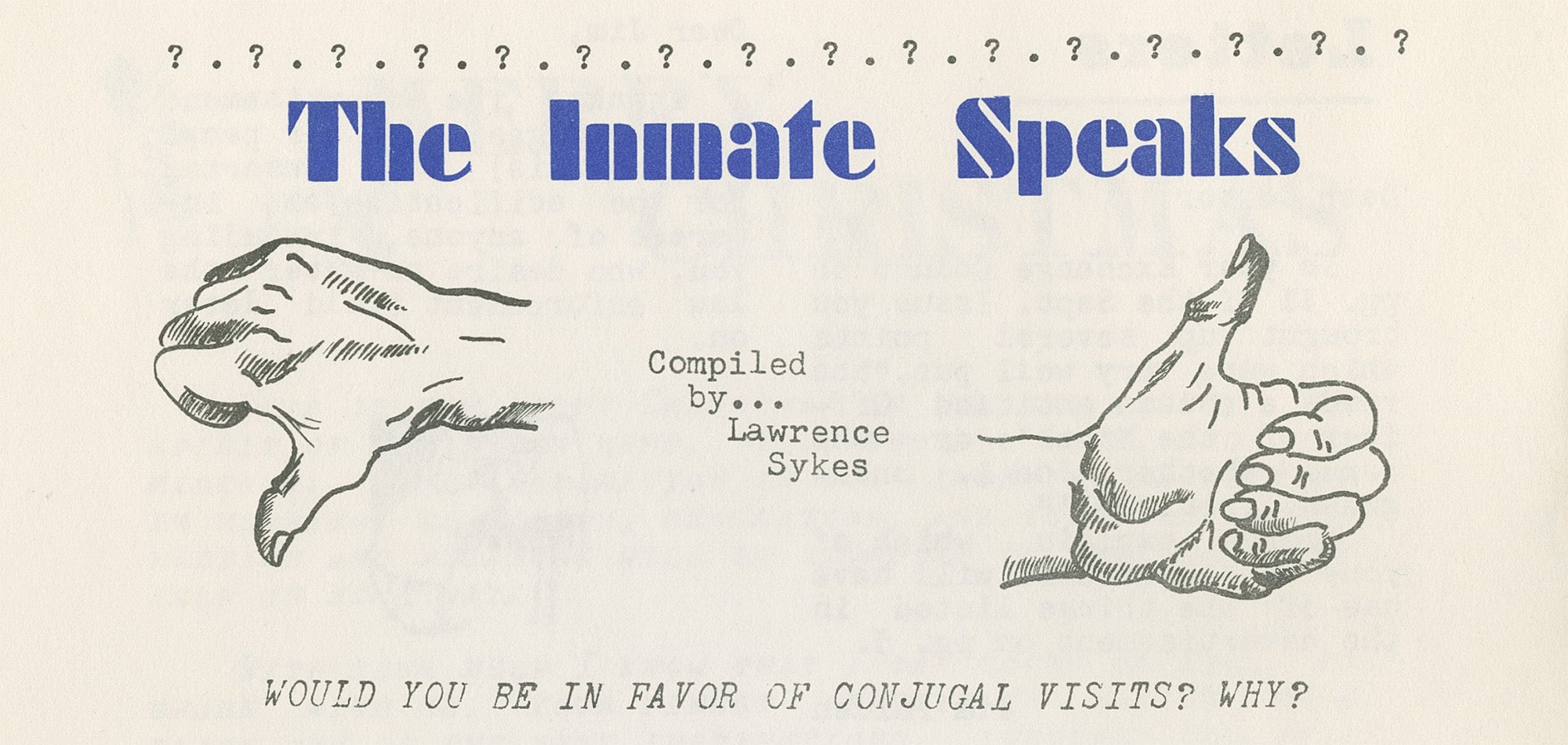
When Parchman officially sanctioned conjugal visits in 1965 after the policy was unofficially in place for years, administrators saw it as an incentive for obedience, but also a solution to what was sometimes called the “ Sex Problem ,” a euphemism for prison rape . Criminologists of the era viewed rape in prison as a symptom of the larger “ problem of homosexuality ,” arguing that the physical deprivations of prison turned men into sexual deviants—i.e., men who wanted to have sex with other men. In this context, conjugal visits were meant to remind men of their natural roles, not merely as practitioners of “ normal sexuality ,” but as husbands. (Framing prison rape as a problem of ‘homosexuals’ was commonplace until Wilbert Rideau’s Angolite exposé Prison: The Sexual Jungle revealed the predation for what it was in 1979.)
Officials at Parchman, the sociologist Columbus B. Hopper wrote in 1962 , “consistently praise the conjugal visit as a highly important factor in reducing homosexuality, boosting inmate morale, and… comprising an important factor in preserving marriages.” Thus making the visits, by definition, conjugal, a word so widely associated with sex and prison that one can forget it simply refers to marriage. Men—and at the time, conjugal visits were only available to men—had to be legally married to be eligible for the program.
But for the men at Somers, the best argument for conjugal visitation was obvious—with one telling detail. The privacy afforded by the red houses at Parchman, Richard Brisson wrote “preserve some dignity to the affair,” creating “a feeling of being a part of a regular community rather than … participating in something that could be made to appear unclean.” For lovers secluded in bedrooms, “[t]here is no one about to mock them or to embarrass them,” he wrote. This observation suggests the ubiquity of surveillance in prison, as well as its character.
Carceral institutions are intended to operate at a bureaucratic remove; prisoners are referred to by number and were counted as “ bodies .” Guards must act as ambivalent custodians of these bodies, even when the nature of their job can be quite intimate. Prisoners are routinely strip-searched and frisked; they must ask permission to exercise any movement, to perform any bodily function. This is as true today as it was in Somers, where men frequently complained that they were treated like children. “You are constantly supervised, just as if you were a one-year-old child,” Ray Bosworth wrote in 1970 .
But guards are not parents, and the tension between dutiful ambivalence and intimate supervision often manifests as disgust. On a recent visit to Bedford Hills Correctional Facility, a maximum-security women’s prison in upstate New York, prisoners complained of being ridiculed during strip searches, and hearing guards discussing their bodies in the corridors.

This attitude extends to rules regulating touch between prisoners and visitors. Writing about San Quentin State Prison in California in the early 2000s, the ethnographer Megan L. Comfort described a common hierarchy of visits , each with its own allowable “degree of bodily contact.” Death Row cage visits allowed for hugs in greeting and parting, while a contact visit allowed for a hug and a kiss. The nature of the kiss, however, was subject to the discretion of individual guards. “We are allowed to kiss members of our families, hello and goodbye, but the amount of affection we may show is limited by the guard,” James Abney wrote for the Somers Weekly Scene in 1971. “If he feels, for instance that a man is kissing his wife too much or too passionately, then he may be reprimanded for it or the visit may be ended on the spot.”
When Somers held its first “ Operation Dialogue ,” a “mediated discussion” among prisoners and staff in May 1971, conjugal visits were a primary concern. By then, California (under Governor Ronald Reagan) had embraced the policy—why hadn’t Connecticut? Administrators argued that furloughs, the practice of allowing prisoners to go home for up to several days, were a preferable alternative. This certainly would seem to be the case. In August 1971, the Scene quoted Connecticut Correction Commissioner John R. Manson, who criticized the skeezy, “tar-paper shacks” at Parchman, concluding that furloughs were “ a less artificial way for inmates to maintain ties with their families .” But to be eligible for furloughs, men were required to be within three or four months of completing their sentence. In the wake of George H.W. Bush’s infamous “ Willie Horton ” campaign ad in 1988, a racially-charged ad meant to stoke fear and anti-Black prejudice in which a violent attack was blamed on Liberal soft-on-crime policies (specifically scapegoating Michael Dukakis for a crime committed on a prison furlough that predated his tenure as governor), prison furloughs were mostly abolished. They remain rare today, still looming in the shadow of the Horton ad.
Conjugal visits are considered a rehabilitative program because, as Abney wrote, it is in “society’s best interest to make sure that [a prisoner’s] family remains intact for him to return to.” Unspoken is the disregard for people serving long sentences, or life, making conjugal visits unavailable to those who might need them the most.
The campaign for conjugal visits continued throughout the 1970s. Then, in 1980, in a sudden and “major policy reversal ,” the state of Connecticut announced that it would instate a “conjugal and family visit” program at several prisons, including Somers. Subsequent issues of the Scene outline the myriad rules for application, noting that applicants could be denied for a variety of reasons at the discretion of prison administrators.
The earliest conjugal visits at Somers lasted overnight but were less than 24 hours in total. Men could have multiple visitors, as long as they were members of his immediate family. This change signaled a new emphasis on domesticity over sex. Visits took place in trailers equipped with kitchens, where families cooked their own meals. Describing a similar set-up at San Quentin more than two decades later, Comfort wrote that the trailers were meant to encourage “people to simulate an ordinary living situation rather than fixate on a hurried physical congress.”
By the early 1990s, conjugal visitation, in some form, was official policy in 17 states. But a massive ideological shift in the way society viewed incarcerated people was already underway. In a seminal 1974 study called “What Works?”, sociologist Robert Martinson concluded that rehabilitation programs in prison “ had no appreciable effect on recidivism .” Thinkers on the left saw this as an argument for decarceration—perhaps these programs were ineffective because of the nature of prison itself. Thinkers on the right, and society more broadly, took a different view. As (ironically) the Washington Post observed, the findings were presented in “lengthy stories appearing in major newspapers, news magazines and journals, often under the headline, ‘ Nothing Works! ’”
Martinson’s work gave an air of scientific legitimacy to the growing “tough-on-crime” movement, but the former Freedom Rider, who once spent 40 days at Parchman, spawned punitive policies he couldn’t have predicted. In 1979, Martinson officially recanted his position. He died by suicide the following year.
In Mistretta v. United States (1989), the court ruled that a person’s demonstrated capacity for rehabilitation should not be a factor in federal sentencing guidelines because, they wrote, studies had proved that rehabilitation was “an unattainable goal for most cases.” It effectively enshrined “nothing works” into law.
Weekly Newsletter
Get your fix of JSTOR Daily’s best stories in your inbox each Thursday.
Privacy Policy Contact Us You may unsubscribe at any time by clicking on the provided link on any marketing message.
“Nothing works” gave rise to harsher sentencing, and more punitive policies in prisons themselves. In 1996, the state of California drastically reduced its conjugal visitation program . At San Quentin, this meant conjugal visits would no longer be available for people serving life sentences. To have benefitted from the program, and then have it taken away, was a particular blow to prisoners and partners alike. One woman told Comfort that she was in “mourning,” saying: “To me, I felt that it was like a death. ”
We don’t know how the men at Somers might have felt about this new era, or the heyday of conjugal visits that came before it. There are no issues of the Weekly Scene available after 1981 in the American Prison Newspapers collection, which is just after the visits began. But their writing, particularly their poetry, offers some insight into the deprivation that spurred their request. In 1968, James N. Teel writes, “Tell me please, do you ever cry, / have you ever tried to live while your insides die? ” While Frank Guiso , in 1970, said his existence was only an “illusion.” “I love and I don’t, / I hate and I don’t / I sing and I don’t / I live and I don’t,” he writes. But for others, disillusionment and loneliness take a specific shape.
“I wish you could always be close to me,” Luis A. Perez wrote in a poem called “ The Wait ” 1974:
I will hold your strong hand in my hand, As I stare in your eyes across the table. Trying to think of the best things to say, I then notice how I will not be able. I will long for your tender embraces, For your long and most desirable kiss. As I sleep cold for warmth of your body, You my love, are the one I will miss…
Today, only four states—California, Connecticut, Washington and New York—allow conjugal visits. (Mississippi, where Parchman is located, ended conjugal visitation in 2014 .) Some argue that Connecticut’s Extended Family Visit (EFV) program, as it is now called, doesn’t actually count , because it requires a prisoner’s child to be there along with another adult . There is also some suggestion that Connecticut’s program, while still officially on the books, has not been operational for some time.
The COVID-19 pandemic gave further cause to limit contact between prisoners and visitors, engendering changes that don’t appear to be going away anytime soon.
Somers was reorganized as a medium-security facility and renamed the Osborn Correctional Institution in 1994. A recent notice on the facility’s visitation website reads: “Masks must be worn at all times. A brief embrace will be permitted at the end of the visit .”
Support JSTOR Daily! Join our new membership program on Patreon today.

JSTOR is a digital library for scholars, researchers, and students. JSTOR Daily readers can access the original research behind our articles for free on JSTOR.
Get Our Newsletter
More stories.

- A People’s Bank at the Post Office

- Culinary Fusion in the Ancient World

- Postcards Revolutionized Pornography

Colorful Lights to Cure What Ails You
Recent posts.
- I Hear America Singing
- London Planetrees, Moon Time, and Dunning-Kruger
Support JSTOR Daily
Sign up for our weekly newsletter.

Reckoning with the South

This couple wants you to know that conjugal visits are only legal in 4 states
- Click to share on Twitter (Opens in new window)
- Click to share on Facebook (Opens in new window)
- Click to share on Pocket (Opens in new window)
- Click to email a link to a friend (Opens in new window)

Editor's note: This story was co-written by inside-outside couple Steve Higginbotham and Jordana Rosenfeld, weaving together Jordana's personal experience and reporting with letters from Steve. Together, they examine popular myths around conjugal visits, their decreasing availability, and the punitive logic behind the state's policing of sex and intimacy that stifles relationships like theirs. Jordana's words appear below in the orange boxes on the right; Steve's are in the purple on the left.

The other day, when I told my grandmother I was researching the history of conjugal visits for an essay, she said, "Oh, like in my stories?"
You can't talk about conjugal visits without talking about television, because television is pretty much the only place where conjugal visits still exist. A wide variety of TV shows either joke about or dramatize conjugal visits, from popular sitcoms that have little to nothing to do with prison life, like The Simpsons , Family Guy , and Seinfeld, to prestige dramas like Prison Break and Oz that purport to offer "gritty" and "realistic" prison tales. Conjugals loom large in public imagination about life in prison, which leaves people under the unfortunate impression that they are in any kind of way widespread or accessible.
Their availability has been in steady decline for more than 25 years. The mid-to-late 1990s are the often-cited high point of conjugal visits , with 17 states offering some kind of program. (Federal and maximum security prisons do not allow conjugals.) This means that at their most widespread, conjugal visits were only ever permitted in one-third of all states.
There are only four U.S. states that currently allow conjugal visits, often called "extended" or "family" visits: California, Connecticut, New York, and Washington. Some people say Connecticut's program doesn't count though, when it comes to conjugals—and the Connecticut Department of Corrections agrees. Their family visit program is explicitly intended for the benefit of children and requires that the incarcerated person receiving visitors be a parent. Their child must attend .
My boyfriend has been in prison for 28 years. He was 18 during the high point of conjugal visit programs. That's when the state of Missouri decided to lock him up for the rest of his natural life, effectively sentencing him to a lifetime of deep loneliness and sexual repression, not just because Missouri doesn't offer conjugal visits, but because when you are incarcerated, your body belongs to the state in every possible way—from your labor to your sex life.
Every prison riot ever could have been prevented with some properly organized fucking.

That's my boyfriend, Steve.
Not being able to physically express love—or even lust—builds frustration that boils over in unintended ways.
Intimacy is policed rigidly in prison, and it has certainly worsened over the years. For most people with incarcerated lovers, intimacy happens not on a conjugal visit, but in the visiting room. Visits now may start and end with a brief embrace and chaste kiss. Open mouth kissing has been outlawed. These rules are enforced with terminated visits and even removing a person from the visiting list for a year or more.
Steve and I have kissed a total of six times.
We have also hugged six times, if you don't count us posing with his arm over my shoulder three times for pictures. The kisses were so brief that I'm not sure I remember what they felt like. He told me later on the phone that he knew he had to be the one to pull away from the kiss before we gave the COs in the bubble reason to intervene because I wouldn't. He knew this, somehow, before he ever kissed me. He was right.
When I last visited him in Jefferson City Correctional Center, Steve told me about a real conjugal visit from '90s Missouri.
Years ago, people used to mess around in the visiting room at Potosi [Correctional Center]. Everyone knew to keep their sensitive visitors away from a certain area, because there was frequent sex behind a vending machine. I can neither confirm nor deny that cops were paid to turn a blind eye to it. I met a guy recently in my wing at JCCC who said he had heard of me, and that maybe I knew his father. I did know his father. I didn't have the heart to tell him that I probably saw his conception behind a Coke machine back in 1995.
The increasing restriction of physical touch—the expanded video surveillance of visiting spaces, the use of solitary confinement for the smallest infractions, and the withering of both in-person and conjugal visit programs—reflects the punitive logic that consensual human touch is a privilege that incarcerated people do not deserve.
This is an evil proposition, and it's one that is at the core of the ongoing dehumanization of millions of people in U.S. prisons, and the millions of people like me who love them.
One woman with an incarcerated partner put it to researchers this way: "The prison system appears to be set up to break families up." And she's right. For the duration of his incarceration, I will never be closer to Steve than the state of Missouri is. I'm reminded during each of our timed kisses: His primary partner is the state.
The most difficult part for me about a romantic relationship with a free woman is that I feel selfish. A lot of self-loathing thoughts creep in. I want the best for her and often question if I am that "best." However, an added benefit is that we can truly take things slowly and explore each other in ways that two free people don't often experience nowadays. We write emails daily. And these are important. We vent. And listen. We continue to build, whereas many free people stop building at consummation.
But these are the realities rarely captured in media portrayals of romantic relationships between free world and incarcerated partners. Conjugals on TV are so disconnected from what it's actually like to be in a romantic relationship with an incarcerated person: Trying to schedule my life around precious 15 minute phone calls, paying 25 cents to send emails monitored by correctional officers, finding ways to symbolically include Steve in my life, like leaving open the seat next to me at the movies. Instead, television shows depict implausible scenarios of nefarious rendezvous that often parrot law enforcement lies. When they do so, they undermine the public's ability to conceptualize that love and commitment fuel relationships like ours.
Although contraband typically enters prisons through staff , not visitors , television shows often present conjugal visits as a cover for smuggling, like in the earliest TV plot I could find involving a conjugal visit, from a 1986 Miami Vice episode. After his girlfriend is killed, Tubbs gets depressed enough to agree to go undercover at a state prison to bust some guards selling cocaine. In his briefing on the issue, Tubbs asks how the drugs are getting into the prison. Conjugal visits and family visits are the first two methods named by the prison commissioner, never mind that I have yet to find any evidence that Florida ever allowed those kinds of visits.
Often, the excuse for policing visits so strictly is that drugs can be exchanged. But I know that lie is used for every type of control in prison. For over a year we had NO CONTACT visits because of the pandemic. During that time, dozens of inmates [at my facility] still overdosed and had drug-related episodes that caused them to need medical attention. Those drugs certainly didn't arrive through visits. They strip search and X-ray me going to and from visits anyway.
Everything in prison now is on camera. When a drug overdose occurs, the investigators track back over footage from visiting room cameras. One officer told me that while they were investigating drugs allegedly passing through the visiting room, they saw a guy covertly fingering his wife. This has happened on more than one occasion, but most guards will have enough of a heart not to bother with violations for some covert touching that wasn't caught until the camera review. Most. Sometimes, a rare asshole will just have to assert his power and write a CDV (conduct violation).
Write-ups or CDVs are given by staff at their discretion. The threat of solitary confinement is always looming in prison. It's another clever way of withholding physical interactions with other human beings as a form of torture. Solitary confinement for anywhere from 10 days to three months is a favorite punishment for "[nonviolent] sexual misconduct. "
There's also a persistent media narrative that prison systems offer conjugal visit programs out of genuine concern for human welfare. A brief glance at the origins of conjugal visits in the U.S. prison system quickly disproves that theory, showing that conjugal visit programs were conceived as a tool of exploitation and social control.
Conjugal visits originated in Mississippi at the infamous prison plantation, Mississippi State Penitentiary, or Parchman Farm. Mississippi state officials opened Parchman in the early 1900s, writes historian David Oshinsky in his book Worse than Slavery: Parchman Farm and the Ordeal of Jim Crow Justice, in order to ensnare free Black people into forced labor. Mississippi, like other Southern states during Reconstruction, passed "Black Codes" that assigned harsh criminal penalties to minor "offenses" such as vagrancy, loitering, living with white people, and not carrying proof of employment—behaviors that were not considered criminal when done by white people. Using the crime loophole in the relatively new 13th Amendment, Mississippi charged thousands of Black people with crimes and forced them to work on the state's plantation.
Parchman officials started offering sex to Black prisoners as a productivity incentive, "because prison officials wanted as much work as possible from their Negro convicts, whom they believed to have greater sexual needs than whites," Oshinsky writes.
"I never saw it, but I heard tell of truckloads of whores bein' sent up from Cleveland at dusk," said a Parchman prison official quoted by Oshinsky. "The cons who had a good day got to get 'em right there between the rows. In my day, we got civilized—put 'em up in little houses and told everybody that them whores was wives. That kept the Baptists off our backs."
A certain kind of sexual morality has been instilled in the minds of many people with conservative religious upbringings. They naturally force this morality on people they consider children. That is how many guards see prisoners: as children.
Many states did not begin to join Mississippi in offering conjugal visits until much later in the century, when conservative governors like California's Ronald Reagan would determine in 1968 that allowing some married men to have sex with their wives was the best way to reduce " instances of homosexuality " in prisons.
Abolitionists who wrote the book Queer (In)Justice , consider how concerned prison administrations have historically been and continue to be about queer sex in prisons. The book exposes both the deep fear of the liberatory potential of queer sexuality, and a broader reality that prisons are inherently queer places since prisons' "denial of sexual intimacy and agency is a quintessential queer experience."
Beyond behavioral control, the rules that determine conjugal visit eligibility are always also about enforcing criminality, since the state decides what kind of charges render someone ineligible to wed or to have an extended visit. Even in the four states that allow these visits, most people with "violent" charges are only allowed to hold their lover's hand and briefly embrace at the beginning and end of visits.
We don't even have enough privacy to masturbate.
I can be written up if anyone sees my dick, especially in the act of masturbation. I could face solitary confinement, loss of job, visits, religious programs, treatment classes, recreation, canteen spend, and school for getting written up. Conversely, I can be strip-searched at any given time and be forced to show everything.
Living in this fishbowl has taught me there is no hiding. Too many bored eyes in the same small area to miss anything. Guards may come knocking on the door at any moment. My cellmate is often inches away from me, and it takes coordination to manage time away from each other because we eat, sleep, go to yard, and do just about everything on the same schedule.
I choose to skip a meal occasionally and embrace the hunger, because it is much less painful than persistent relentless desire. After years of self-release in showers, in a room with snoring cellmates, or as quickly as possible when a brief moment of privacy occurs, my sex drive is all shook up. Current turn-ons could be said to include faucets running and/or snoring men.
Ultimately, this article is not about the right to conjugal visits. It's about the ways that punitive isolation and deprivation of loving physical contact have always been tactics of the U.S. prison system.
Regardless of the quality of the representations, the prevalence of conjugal visits in movies and TV allows people to avoid thinking too hard about what it's like to be deprived of your sexual autonomy, maybe the rest of your life.
I have been locked up since I was 18, and I am 47 now. To be horny in prison for decades is painful. To the body and soul.
There is justice as well as pleasure at stake here, and the difference between the two is slight.
People who love someone in prison live shorter and harder lives. That we do it anyway shows the significance, centrality, and life-affirming nature of intimate relationships to those on both sides of the wall. Maybe it even points to the abolitionist power of romantic and sexual love between incarcerated and "free" people.
So, I guess we start with that thought and work from there to find a way to tear down the system.

As part of Scalawag's 3rd annual Abolition Week, pop justice is exclusively featuring perspectives from currently and formerly incarcerated folks and systems-impacted folks.
More in pop justice:.

'It's not a story—it's a life:' A look at Snapped, from the inside

Come on Barbie, give us nothing!

Barbie: Pretty Police

"Pull up your pants or go to jail!"
Related stories:, steve higginbotham & jordana rosenfeld.
Steve Higginbotham is a writer who spent many years narrating and transcribing materials into braille for the Missouri Center for Braille & Narration Production . He is serving a death by incarceration sentence in Jefferson City, Missouri. Jordana Rosenfeld is a journalist in Pittsburgh, Pennsylvania. More of her work can be found at jordanarosenfeld.com .
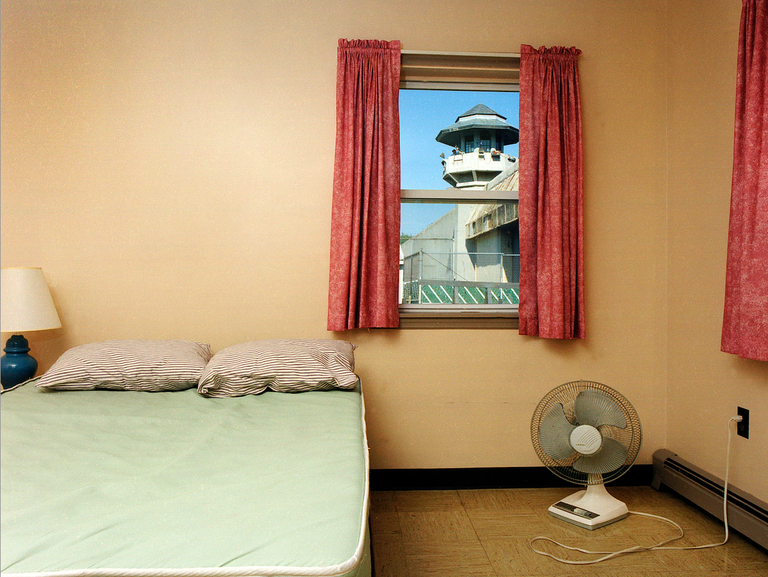
Sex, Love, & Marriage Behind Bars
What are conjugal visits really like? Incarcerated journalist John J. Lennon takes Esquire inside one of the last bastions of prisoner intimacy in America: trailers of New York.
I first heard about the trailers, prison vernacular for conjugal visits, on Rikers Island. It was 2002, I was twenty-four, and I was awaiting trial on murder charges. The guy the next bunk over in the communal dorm knew I was facing a lot of time, even if I didn’t know that. I was delusional in the beginning. We all are.
The bunkmate had just finished a dime—a ten-year sentence—for assault and was now in on a parole violation for breaking curfew, caught on a tip called in by his wife. Still, he loved her, and he loved telling me about going on conjugals with her up in Auburn, a maximum-security prison. It wasn’t just about the sex, he said. It was forty-eight hours of freedom, or close to it. Most of New York’s maximum-security prisons had them. They weren’t trailers, not anymore, but modular homes. He described the units: two, sometimes three bedrooms—the prison supplied pillows, bed linens, towels, and washcloths—a living room, a bathroom, and a full kitchen stocked with pots and pans, a coffee maker, a blender, and utensils. A wire bolted to the counter next to the sink was connected to the handle of the kitchen knife. His wife would bring clothes, cosmetics, and groceries: milk, eggs, pork chops, shelled shrimp. Glass containers weren’t allowed; neither was alcohol, not even as a makeup ingredient. Outside there was a picnic table, a barbecue pit, and a children’s play area.

It was, the fella in the next bunk told me, an opportunity for good times, good eating, and good sex. An incentive to stay out of trouble in the hope of experiencing a touch of love.
There was a hitch: Your partner had to be your legal spouse. Close family members were also eligible, of course, and this was really the objective of these visits: to build and maintain better family ties. But that was beside my bunkmate’s point. If I was convicted, he said, he recommended I put an ad on one of those prisoner dating websites (Prison Pen Pals, Write a Prisoner), find a woman, fall in love, make it official, then head for the trailers.
In 2004, I was sentenced to twenty-eight years to life. The minimum was longer than I’d been alive. Early on, I didn’t think much about the implications for my love life. At twenty-four, I’d had plenty of sex but never a real relationship, or even healthy intimacy. Besides, there were more pressing concerns: appealing my conviction, learning how to survive in this place.
I first saw the trailers at Clinton Correctional, a maximum-security prison a few miles south of the Canadian border, in Dannemora. By then I’d learned that New York’s Department of Corrections and Community Supervision didn’t actually call them conjugal visits. Only Mississippi did. While the word conjugal simply means “related to marriage,” these visits began to carry lewd implications, and other states opted to rebrand: In California, it was known as “family visiting.” In Connecticut and Washington, they were referred to as “extended family visits.” In New York, it was, and still is, called the Family Reunion Program, or FRP.

In 2005, I had my first FRP visit—with my mother and my aunt. My aunt cooked bacon and eggs in the morning, grilled porterhouse steaks and tossed salads for dinner. We sank into the soft couches, ate, and watched Law & Order reruns, oddly Mom’s favorite show. We talked until interrupted by the muffled screams of a couple through the wall of the attached unit. We laughed awkwardly, avoiding eye contact, and I felt kind of jealous. Three times a day, a phone in the unit rang. I picked up, spat my last name and identification number into the receiver, then stepped outside and waved to the watchtower guard. That count was one of the only reminders of prison.
When I returned to my block, guys asked how the conjugal had gone. Great, I said. When I mentioned it was with my mother and my aunt, they sort of nodded, like, Oh, that’s cool, too. I loved visiting with my family. But I did start to think about what it would be like to be with a woman again.
.css-f6drgc:before{margin:-0.99rem auto 0 -1.33rem;left:50%;width:2.1875rem;border:0.3125rem solid #FF3A30;height:2.1875rem;content:'';display:block;position:absolute;border-radius:100%;} .css-1aglugu{font-family:Lausanne,Lausanne-fallback,Lausanne-roboto,Lausanne-local,Arial,sans-serif;font-size:1.625rem;line-height:1.2;margin:0rem;}@media(max-width: 48rem){.css-1aglugu{font-size:1.75rem;line-height:1.2;}}@media(min-width: 64rem){.css-1aglugu{font-size:2.375rem;line-height:1.2;}}.css-1aglugu b,.css-1aglugu strong{font-family:inherit;font-weight:bold;}.css-1aglugu em,.css-1aglugu i{font-style:italic;font-family:inherit;}.css-1aglugu:before{content:'"';display:block;padding:0.3125rem 0.875rem 0 0;font-size:3.5rem;line-height:0.8;font-style:italic;font-family:Lausanne,Lausanne-fallback,Lausanne-styleitalic-roboto,Lausanne-styleitalic-local,Arial,sans-serif;} Trailer visits were never perfect. Sometimes they were hard. But in many ways, they felt like rehearsals for life on the outside.
I got by with my hand and my memories, with the occasional assist from Buttman or High Society. Many of us who’ve been locked up all these years try idiosyncratic methods to pleasure ourselves. Some use a Fifi—a rolled towel with a plastic bag stuffed in the crevice; inside the bag is a rubber glove lubed with Vaseline that can be warmed in a hot pot of water, if one prefers. The crevice can be tightened or loosened by a strap wrapped around the rolled towel, creating different sensations. Fucking Fifis was an intimate ritual for one of my neighbors. At night he hung a curtain across his cell bars, prepped his Fifi, rolled the whole thing up in his mattress—he said it was more like a big-booty girl that way—laid out a few porno mags, and started thrusting.
But I wasn’t looking to hump a Fifi for the next twenty-five years.
Married men in the joint who went on conjugals seemed to have the most meaningful lives: They worked out, they went on visits, they sported crispy new sneakers and polo shirts with the horse, as if to say to the rest of us, I got a lady who loves me, and I got more status than you. At least, that’s how I took it. Every few months, they disappeared—most men kept their conjugal dates to themselves to avoid attracting envy—but we all knew where they’d gone. They came back to the cellblock with hickey-covered necks, looking pleasantly tired. I decided that was how I wanted to serve my sentence.
Mississippi State Penitentiary, of all places, was the first facility in the U. S. to offer conjugal visits, in the early 1900s. Also known as Parchman Farm, the segregated prison functioned as a revenue-generating plantation that produced cotton, cattle, pork, and more; its prisoners performed all the hard labor. To incentivize their work, administrators began arranging for prostitutes to visit on Sundays, and prisoners slept with them wherever they could—tool sheds, storage areas, the barracks. At first, only Black prisoners were allowed to participate, and for deeply racist notions “about Black men’s allegedly voracious sexual natures and appetites,” says Heather Ann Thompson, author of the Pulitzer-prize-winning history of the Attica uprising, Blood in the Water, “that Black prisoners could be forced to work even harder not just under threat of the lash but also, due to their savage nature, the promise of sex.”

Starting around 1940, all of Parchman’s prisoners were able to participate, regardless of race. By the late fifties, prostitutes were banned, replaced by prisoners’ spouses, common-law wives, and female friends. In 1972, the program opened to the facility’s female prisoners. Still, the system was marked by prejudice. “The most important question concerning a program of conjugal visiting,” wrote Columbus Hopper in his 1969 study of Parchman, Sex in Prison, “is whether it helps to reduce the problem of homosexuality in prison.” Hopper was the leading conjugals researcher of his time, and the “problem of homosexuality” seems to have been one of the main forces behind his advocacy. Truth is, in my twenty-one years of incarceration, I’ve never been sexually assaulted or witnessed that kind of assault.
New York’s first FRP began in 1976, with five 12-foot-by-70-foot trailers in a former cow pasture at Wallkill Correctional. Attica got its trailers in 1977, six years after the prisoner uprising for more humane treatment that, when law enforcement took back the prison, left thirty-nine dead. In the first eighteen months of Attica’s FRP, 1,179 prisoners participated.
By 1993, seventeen states allowed some version of extended family visits. That year in New York, 12,401 family members attended FRPs across the state. “The effectiveness of the program is beyond dispute,” the prison commissioner wrote in an op-ed around that time.
Data supports the former commissioner’s claims. According to a recent literature review, prisons that allow conjugal visits have better disciplinary records than those that do not. What’s more, studies have determined that released prisoners with an established relationship have a much better chance of not returning to prison. (In 1980, New York’s corrections department published findings suggesting that participation in the program decreased recidivism rates by as much as 67 percent.)
Yet since the start of such programs, fierce resistance has followed. By the early nineties, the era of mass incarceration was fully under way, and across the country, prison programs that incentivized good behavior—furloughs, work release, college, conjugals—were on the chopping block. Why, the thinking went, should we coddle criminals with taxpayer money? (It’s worth noting that FRP upkeep is paid for in part by prisoner fundraisers.) And don’t conjugals present one more way to introduce contraband?
As early as 1969, when Hopper published his findings on Parchman, conjugal visits were available in Chile, Ecuador, Japan, Mexico, Costa Rica, and the Philippines. Today, that list includes Qatar, Argentina, Brazil, Belgium, Sweden, Spain, France, Russia, and Saudi Arabia.
The United States has shifted in the opposite direction. In the eyes of the law, conjugal visits are a privilege, not a right. The Supreme Court has repeatedly upheld prison administrators’ latitude to limit prisoners’ rights, including visitation, writing in 2003 that “freedom of association is among the rights least compatible with incarceration.” In 2014, Mississippi did away with its program. “There are costs associated with the staff’s time,” the state’s prison commissioner said at the time. “Then, even though we provide contraception, we have no idea how many women are getting pregnant only for the child to be raised by one parent”—as if such family planning were his call to make.
Today, only four states allow conjugal visits—New York, California, Washington, and Connecticut—though when Covid came, Connecticut’s program was suspended, and it has yet to return. Federal prisons don’t offer the privilege. New York’s program has been a success: FRP is offered at twelve of its fifteen maximum-security prisons and eleven of its twenty-six medium-security prisons. Since 2011, same-sex couples have been able to participate. Yet each year over the past decade or so, Republican state senators have introduced a bill to eliminate FRP. Conservatives preach the importance of a solid family structure. Why would they want to sabotage prisoners who are trying to build and maintain theirs?
By 2009, I was in Attica; my appeals had been denied. I was thirty-two and lonely. I’d spend hours each day watching the tiny TV in my cell. The Bachelor was my favorite show—a glimpse of intimacy, however stage-managed, and a break from my bleak reality. I felt like I was squandering an opportunity by not putting myself out there. I told Mom what the guy on Rikers Island had suggested, and she put an ad on the prison dating website Friends Beyond the Wall.
Danielly was a year younger than me and lived with her teenage son in a housing project on the Lower East Side. “I’m Dominican, and brown. Do you like that?” she wrote. Yes, yes, I loved it! In an early letter, I brought up the trailers, told her to imagine an uninterrupted weekend together in a sort of cabin, no cell phones, no distractions—just us. She didn’t need to be sold. Her mom had married a guy who’d done time, she told me, and she remembered visiting those little homes in the prison as a young girl.

Danielly started visiting me at Attica. She was my type—curvy, full of attitude and affection. We had the kind of chemistry that made my stomach flutter. But I soon learned that my type was much harder to handle on the inside than it had been when I was on the outside. The guy she’d described as her ex-boyfriend was more like her current boyfriend. When I called her, she sometimes wouldn’t answer. I was left lovesick, and that’s no way to live in prison. So I let her go.
In January 2011, I started corresponding with Raina, a California blonde, thirty-nine, who’d never been married and had no kids, and it wasn’t a dealbreaker that I’d killed a man. She had a great sense of humor, and while she’d known darkness in her own life, she’d needle anyone who took theirs too seriously. I was hooked. She was emotionally intelligent, we spoke the language of recovery, and our relationship felt safe. She moved across the country for me. One day in 2012, in Attica’s visiting room, I proposed to her, and she said yes. Six months later, we joined a few other couples in a small room with a Goofy mural painted on the wall and Attica’s town clerk seated at a table, and we got married.
By 2014—after a series of applications, denials, appeals, and interviews, including one in which Raina was told I didn’t carry any sexually transmitted diseases—we had our first FRP date.
Two days beforehand, I had to piss in a cup under a guard’s gaze for my drug screen. Then again the day of, and again after I came off the trailer. Most of the work was on Raina: shopping, traveling, then getting processed, food pushed through an X-ray machine, gloved fingers sifting through her panties and K-Y jelly.
The corrections officer escorted a handful of us through the Attica lobby, a part of the prison I had never seen before. Gates opened and closed, and we walked to the FRP compound. A fence enclosed the five red-sided homes, situated so that the rest of the prison couldn’t see in. Though the watchtower guard kept a close eye.
Sitting on the couch, looking around, I felt . . . joy. In the system, you’re always waiting, and never for anything good: trial, sentencing, transfers, getting cuffed and shackled, always in a cell or a bullpen or on a bus eating bologna sandwiches. Now I didn’t know what to do with myself, and I loved it. I got up from the couch, turned on the stereo, then walked outside on the grass, sat on the children’s swing, went back inside. I grabbed the remote, turned on the flat-screen television, flipped through the stations. To do whatever I wanted, and to be waiting for my wife so we could do whatever we wanted—I felt giddy. Through the window I watched my neighbor in his kitchen as he boiled the silverware—forks, (butter) knives, a spatula, a ladle, all metal and engraved with tracking numbers—in one pot of water, and added a few drops of scented oil to another, to perfume the place. Finally, I heard one of the guys yell, “They’re here!”
A corrections van with blue-tinted windows pulled up, and the family members got out. A little boy ran to his father and jumped in his arms. And there was Raina. The CO let me help her with her luggage, which was in a container marked with our unit number.
As soon as the door of our unit closed, we threw the groceries—including cuts of filet mignon and A.1. sauce—on the table and started awkwardly kissing. As we began to undress, there was a knock on the door. Raina put on a shirt and I cracked the door. It was the CO, who just needed our container. It was like that, the conjugals; they were such a departure from regular prison life. Even the staff interactions were all good.

Raina and I got back to it. It was my first time in eleven years, so I figured I’d finish fast. But it was the opposite. We went at it for a while—soft, hard, slow, fast, this way, that way—and nothing seemed to bring either of us closer to climax. It was like I’d never touched a woman before. It felt weird that nobody else was watching us. I eventually pulled out and brought myself to ejaculation.
On some level, we hadn’t expected the first time to be amazing. Though it’s hard to make bad sex better, we had to try. We loved each other. We went on six more FRP visits, but the situation didn’t improve. Our issues were less about friction and more about fantasy, or the lack thereof.
Danielly had sent me letters over the years since we’d first met, none of which I’d replied to. But in 2015, as my relationship with Raina was coming to an end, I finally wrote back, explaining my marital woes. Danielly replied that I never should have gotten married in the first place, that she was my soulmate. She said she was still on and off with her boyfriend, but he didn’t matter. If I got divorced and married her instead, she’d come to Attica and fulfill all my fantasies.
I divorced Raina and proposed to Danielly.
In October, we got married by the same Attica town clerk who’d officiated the last time. The Goofy mural was gone. We posed for our wedding picture in front of a seascape of sea lions and colorful fish. Danielly looks sad in the photo, barely smiling. She’d wanted this day to be so much more special than it was.
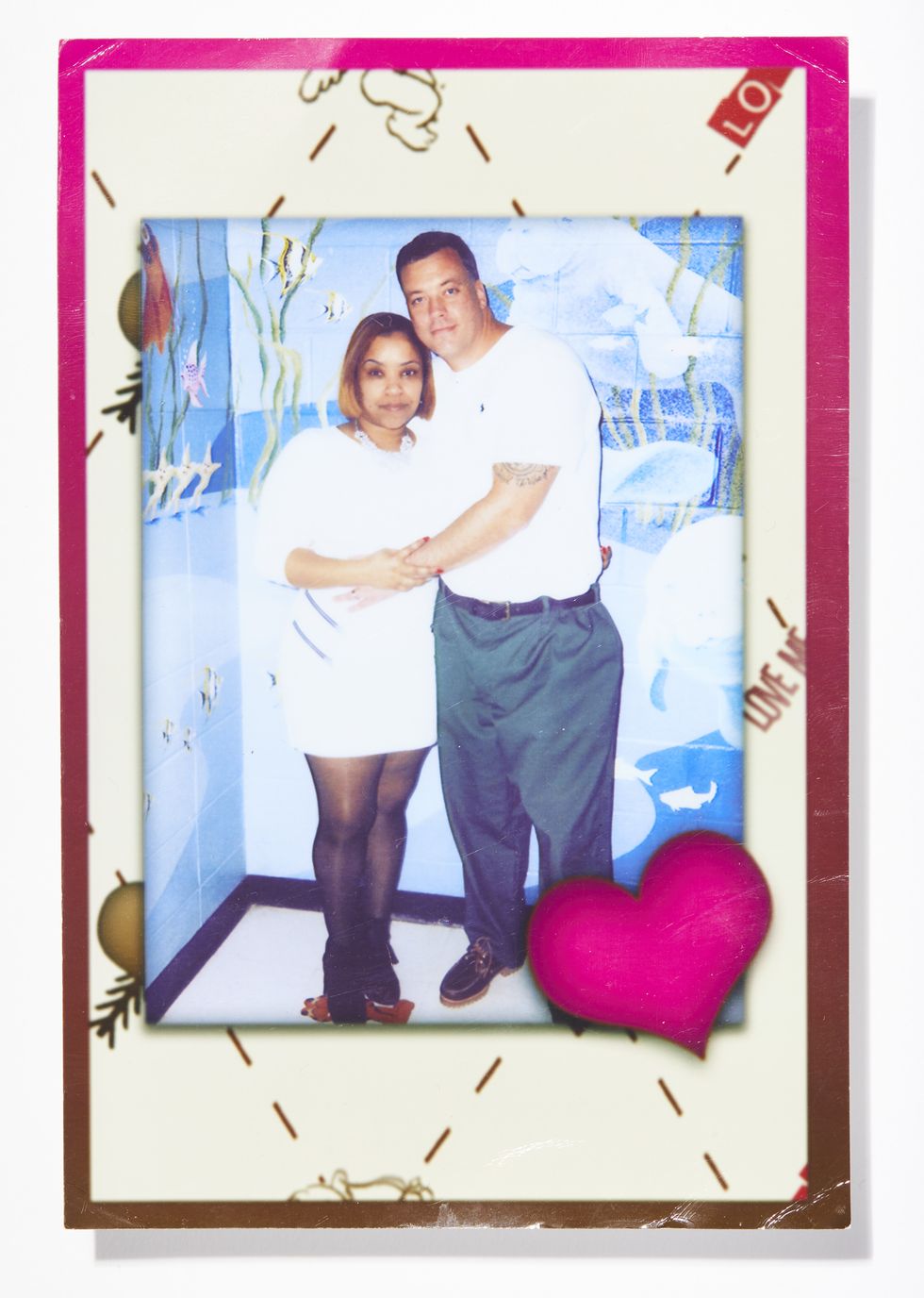
Afterward, I bribed a CO with a few packs of Newports to let the cellblock’s tattoo artist come into my cell, and with a needle made from an uncoiled lighter spring powered by a repurposed beard-trimmer motor, he inked danielly on the inside of my upper arm in looping script. Once she ditched the boyfriend for good, she had my name inked on her forearm. We craved each other. Our kisses, deep and long and wet, always felt like good sex.
I wanted to transfer to Sing Sing, forty miles north of New York City—among other reasons, it would take Danielly an hour by train, as opposed to the eleven-hour bus trip she took both ways to visit me at Attica. But Attica was a disciplinary prison, rife with violence; the number of prisoners on good behavior was low, the FRP waitlist short. You could book a spot every forty or fifty days. At Sing Sing, the wait was closer to ninety days. I weighed the pros and cons. Con: waiting twice as long to be together. Pro: saving Danielly the hassle of a big trip to the middle of nowhere, which would probably mean I’d see her more often.
I submitted my paperwork, got approved, and transferred in November 2016.
In February, we had our first FRP date. The compound was pretty much the same as the one at Attica, but at Sing Sing we got a Polaroid camera and twelve blank photos. Some couples went into the units and did not come out for the allotted forty-eight hours. Others were more social. Me and my friend Andy Gargiulo—convicted in 2006 of killing his reputed mobster brother-in-law; we’d had the same lawyer—would sometimes coordinate our FRP visits. He was a lot older than me, around eighty, but we got along. So did our better halves. His wife brought the best Italian food in Brooklyn—cannolis, fresh mozzarella, and tender veal—and when the weather was nice, the four of us would sit outside and barbecue.
Danielly was provocative, and that turned me on. We argued; we canceled visits on each other. We often had angry, shit-talking sex. Sometimes we played nice, but she’d never let it get to my head. “Boy,” she’d say, “you have so much to learn about women.” We couldn’t have sex for the entire forty-eight hours, but it sometimes felt like we were trying.
Intimacy came in other forms. She introduced me to ASMR; I brewed Bustelo for her and microwaved the half-and-half so it wouldn’t cool off the coffee too much. “Coffee,” by Miguel, became our song. We watched The Notebook, and she recited her favorite lines. We watched Warrior, and when Tom Hardy’s character hugs his drunk father, played by Nick Nolte, Danielly comforted me as I cried.
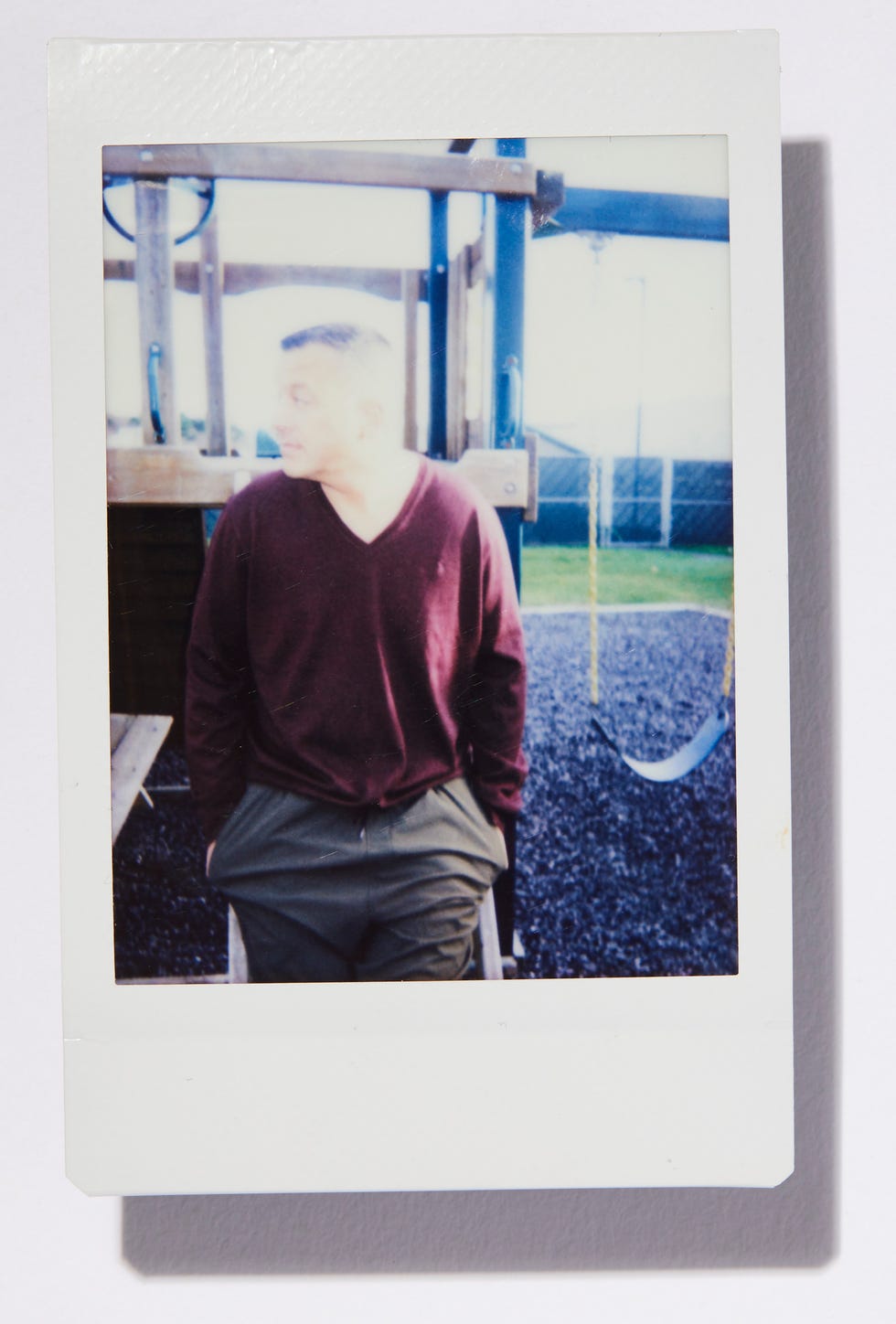
I know now that our relationship wasn’t healthy. My moments of joy were outweighed by my jealousy and anxiety. I’d get annoyed if she didn’t read my latest article. “You’re all into yourself and your career,” she’d say. “Women don’t like that, bro!” Or “I fell in love with the guy at Attica, before he became the writer.” That one hurt. But it’s not like I’d ask about her job as a nurse at a Bronx clinic. She’d want to talk about our future, and I’d urge her to stay in the present. She’d storm off into the bedroom, slam the door, and curse me out in rapid-fire Spanish. Well, I’d think, this is life.
By March 2020, our relationship was rocky. But for the first twenty-four hours of our first FRP in more than a year, we were getting along. As we prepped lunch, a knock came at the door. It was the security captain. Because of Covid, our visit was over, along with our last shot at rekindling.
By the time FRP visits were restored, a year and a half later, I’d been transferred to Sullivan Correctional, in the southern Catskills. Danielly came up twice. But too much time had passed, and other relationships had formed: hers with somebody else, mine with my career. Becoming a journalist in the joint brought its own stress, and my anxiety worsened; things like pissing in a cup with a guard peeking seemed impossible. Recently, we divorced.
Would I have been better off not having experienced intimacy for the past twenty-one years? Would Raina and Danielly have been better off never having met me? I’ve since realized that in both relationships, I focused more on the affection I was getting than the affection I was giving. All this time spent living in my head, confined to a six-foot-by-nine-foot cell, has rendered me less expressive and more emotionally stuck. My thoughts would bounce around my brain but never make it out of my mouth, which left Raina, then Danielly, feeling neglected. The time I used to spend writing love letters I now spend writing articles. Sometimes I feel like I took the two of them for granted. There’s an immense effort, this leap toward love in which the only physical manifestation comes in the form of conjugal visits. And it’s exerted not by the prisoners but by our partners. They wait, they shop, they lug, they travel, they get gossiped about by friends and family and insulted by COs.
Trailer visits were never perfect. Sometimes they were hard, especially at the end—me returning to prison, my woman going home alone. But in many ways, they felt like rehearsals for life on the outside. I believe that because of my experiences with conjugals, when I do get out, I’ll be more sensitive to the feelings of those closest to me. “It remains utterly and inescapably true that to be a human being is to need to be connected to, to bond with, and to be nurtured by other human beings,” Heather Ann Thompson told me. “Serving one’s sentence does not change that.”
So I’m single now. Middle-aged, too. Sometimes I imagine the kind of woman I’ll attract when I’m on the outside, and I wonder if I’ll resent her because she didn’t fall for me when I was on the inside. Which is absurd, and I know I need to work that shit out. But it also feels like a nod to the women who’ve loved me, a thank-you to all the partners who’ve sacrificed so much to share their love with those of us who are locked up.
I think about a moment Danielly and I shared with Andy and his wife, who was wearing Prada glasses and a perfume called La Vie Est Belle. The sun was bright; we sat at the picnic table, eating the best of both kitchens. Andy was talking about a TV show he watched in his cell—maybe it was America’s Got Talent —and Danielly told him how she also loved that show. While recalling the final performance of a child singer who’d recently won, Andy choked up. Right there at the wooden table, surrounded by the thirty-foot concrete wall and the guard with the AR-15 perched in the tower. Danielly teared up, too. “He gets emotional on these visits,” Andy’s wife said in a tough Brooklyn accent, smiling. More than the sex, it’s moments like these—simple, safe, and endearing—that have provided me with what prison has stripped away: a taste of intimacy.

@media(max-width: 73.75rem){.css-1ktbcds:before{margin-right:0.4375rem;color:#FF3A30;content:'_';display:inline-block;}}@media(min-width: 64rem){.css-1ktbcds:before{margin-right:0.5625rem;color:#FF3A30;content:'_';display:inline-block;}} Esquire Select Exclusives

American Tragedy: The Death of an Alabama Pastor

Is It Even Possible to Become More Productive?

The All-American Father

What If Profound Lovesickness Isn’t Romantic?

The Redemption of Al Sharpton
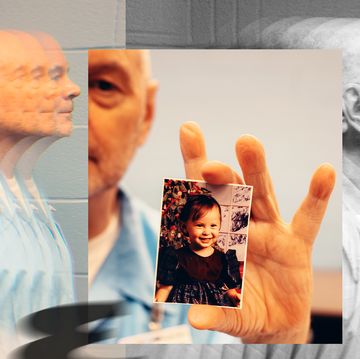
What Really Happened to Baby Christina?

Inside My Mid-Life Crisis

In the War Room with Steve Bannon

There Are Only Two Options Left In Ukraine

I Got Paid For Two Years and Never Did Any Work

I Got Paid to Spy on People While They Worked
Benefits and risks of conjugal visits in prison: A systematic literature review
Affiliations.
- 1 Division of Psychological Medicine and Clinical Neurosciences, School of Medicine, Cardiff University, Cardiff, UK.
- 2 School of Social Sciences, Cardiff University, Cardiff, UK.
- PMID: 34597428
- DOI: 10.1002/cbm.2215
Background: Imprisonment impacts on lives beyond the prisoner's. In particular, family and intimate relationships are affected. Only some countries permit private conjugal visits in prison between a prisoner and community living partner.
Aims: Our aim was to find evidence from published international literature on the safety, benefits or harms of such visits.
Methods: A systematic literature review was conducted using broad search terms, including words like 'private' and 'family', to maximise search sensitivity but strict criteria for inclusion - of visits unobserved by prison staff and away from other prisoners. All included papers were quality assessed. Two of us independently extracted data from included papers, according to a prepared checklist. Meta-analysis was considered.
Results: Seventeen papers were identified from 12 independent studies, all but three of them from North America. The only study of health benefits found a positive association with maintaining sexual relationships. The three before-and-after study of partnership qualities suggested benefit, but conjugal visiting was within a wider family-support programme. Studies with in-prison behaviour as a possible outcome suggest small, if any, association, although one US-wide study found significantly fewer in-prison sexual assaults in states allowing conjugal visiting than those not. Other studies were of prisoner, staff or partner attitudes. There is little evidence of adverse effects, although two qualitative studies raise concerns about the visiting partner's sense of institutionalisation or coercion.
Conclusions: The balance of evidence about conjugal visiting is positive, but there is little of it. As stable family relationships have, elsewhere, been associated with desistance from crime, the contribution of conjugal visiting to these should be better researched.
Keywords: conjugal visit; consensual sex in prisons; imprisonment; prisoners; private visiting.
© 2021 John Wiley & Sons Ltd.
Publication types
- Systematic Review
- Interpersonal Relations
- Risk Assessment
- Sexual Partners
How Do Conjugal Visits Work?

Maintaining close ties with loved ones while doing time can increase the chances of a successful reentry program. Although several studies back this conclusion, it’s widely logical.
While the conjugal visits concept sounds commendable, there’s an increasing call to scrap the scheme, particularly across US states. This campaign has frustrated many states out of the program, leaving only a handful. Back in 1993, 17 US states recognized conjugal visits. Today, in 2020, only four do.
The conjugal visit was first practiced in Mississippi. The state, then, brought in prostitutes for inmates. The program continued until 2014. The scrap provoked massive protests from different right groups and prisoners’ families. The protesters sought a continuance of the program, which they said had so far helped sustain family bonds and inmate’s general attitude to life-after-jail.
New Mexico, the last to scrap the concept, did so after a convicted murderer impregnated four different women in prison. If these visits look as cool as many theories postulate, why the anti-conjugal-visit campaigns in countries like the US?
This article provides an in-depth guide on how conjugal visits work, states that allow conjugal visits, its historical background, arguments for and against the scheme, and what a conjugal visit entails in reality.
What Is a Conjugal Visit?
A conjugal visit is a popular practice that allows inmates to spend time alone with their loved one(s), particularly a significant other, while incarcerated. By implication, and candidly, conjugal visits afford prisoners an opportunity to, among other things, engage their significant other sexually.
However, in actual content, such visits go beyond just sex. Most eligible prisoners do not even consider intimacy during such visits. In many cases, it’s all about ‘hosting’ family members and sustaining family bonds while they serve time. In fact, in some jurisdictions, New York, for example, spouses are not involved in more than half of such visits. But how did it all start?

History of Conjugal Visits
Conjugal visits origin dates back to the early 20 th century, in the then Parchman Farm – presently, Mississippi State Penitentiary. Back then, ‘qualified’ male prisoners were allowed to enjoy intimacy with prostitutes, primarily as a reward for hard work.
While underperforming prisoners were beaten, the well-behaved were rewarded in different forms, including a sex worker’s company. On their off-days, Sunday, a vehicle-load of women were brought into the facility and offered to the best behaved. The policy was soon reviewed, substituting prostitutes for inmates’ wives or girlfriends, as they wished.
The handwork-for-sex concept recorded tremendous success, and over time, about a quarter of the entire US states had introduced the practice. In no time, many other countries copied the initiative for their prisons.
Although the United States is gradually phasing out conjugal visits, the practice still holds in many countries. In Canada, for instance, “extended family visits” – a newly branded phrase for conjugal visits – permits prisoners up to 72 hours alone with their loved ones, once in few months. Close family ties and, in a few cases, friends are allowed to time alone with a prisoner. Items, like foods, used during the visit are provided by the visitors or the host – the inmate.
Over to Asia, Saudi Arabia is, arguably, one of the most generous countries when it comes to conjugal visits. Over there, inmates are allowed intimacy once monthly. Convicts with multiple wives get access to all their wives – one wife, monthly. Even more, the government foots traveling experiences for the visitors.
Conjugal visits do not exist in Great Britain. However, in some instances, prisoners incarcerated for a long period may qualify to embark on a ‘family leave’ for a short duration. This is applicable mainly for inmates whose records suggest a low risk of committing crimes outside the facility.
This practice is designed to reconnect the inmates to the real world outside the prison walls before their release . Inmates leverage on this privilege not just to reconnect with friends and family, but to also search for jobs , accommodation, and more, setting the pace for their reintegration.
Back to US history, the family visit initiative soon began to decline from around the ’80s. Now, conjugal visits only exist in California, New York, Connecticut, and Washington.

Is the Increasing Cancellation Justifiable?
The conjugal visit initiative cancellation, despite promising results, was reportedly tied around public opinion. Around the ’90s, increasing pressure mounted against the practice.
One of the arguments was that convicts are sent to jail as a punishment, not for pleasure. They fail to understand that certain convictions – such as convictions for violent crimes – do not qualify for conjugal visit programs.
The anti-conjugal visit campaigners claim the practice encouraged an increase in babies fathered by inmates. There are, however, no data to substantiate such claims. Besides, inmates are usually given free contraceptives during the family visits.
Another widely touted justification, which seems the strongest, is the high running cost. Until New Mexico recently scraped the conjugal visit scheme, they had spent an average of approximately $120,000 annually. While this may sound like a lot, what then can we say of the approximately $35,540 spent annually on each inmate in federal facilities?
If the total cost of running the state’s conjugal visit program was but equivalent to the cost of keeping three inmates behind bars, then, perhaps, the scrap had some political undertones, not entirely running cost, as purported.
Besides, an old study on the population of New York’s inmates postulates that prisoners who kept ties with loved ones were about 70 percent less likely – compared to their counterparts who had no such privilege – to become repeat offenders within three years after release.
Conjugal Visit State-by-State Rules
The activities surrounding conjugal visits are widely similar across jurisdictions. That said, the different states have individual requirements for family visitation:
California: If you’re visiting a loved one in a correctional facility in California, among other rules , be ready for a once-in-four-hours search.
Connecticut : To qualify, prisoners must not be below level 4 in close custody. Close custody levels – usually on a 1-to-5 scale – measures the extent to which correctional officers monitor inmates’ day-to-day activities.
Also, inmates should not be on restriction, must not be a gang member, and must have no records of disciplinary offenses in Classes A or B in the past year. Besides, spouse-only visits are prohibited; an eligible member of the family must be involved.
New York : Unlike Connecticut and Washington, New York’s conjugal visit rules – as with California’s – allow same-sex partners, however, not without marriage proof.
Washington : Washington is comparatively strict about her conjugal visit requirements . It enlists several crimes as basis for disqualifying inmates from enjoying such privileges. Besides, inmates must proof active involvement in a reintegration/rehabilitation scheme and must have served a minimum time, among others, to qualify.
However, the rule allows joint visits, where two relatives are in the same facility. Visit duration varies widely – between six hours to three days. The prison supervisor calls the shots on a case-to-case basis.
As with inmates, their visitors also have their share of eligibility requirements to satisfy for an extended family visit. For instance, visitors with pending criminal records may not qualify.
As complicated as the requirements seem, it can even get a bit more complex. For instance, there is usually a great deal of paperwork, background checks, and close supervision. Understandably, these are but to guide against anything implicating. Touchingly, the prisoners’ quests are simple. They only want to reconnect with those who give them happiness, love, and, importantly, hope for a good life outside the bars.
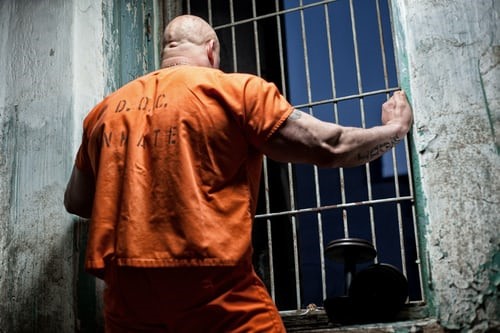
Conjugal Visits: A Typical Experience
Perhaps you’ve watched pretty similar practices in movies. But it’s entirely a different ball game in the real world. Besides that movies make the romantic visits seem like a trend presently, those in-prison sex scenes are not exactly what it is in reality.
How, then, does it work there? As mentioned, jurisdictions that still allow “extended family visits” may not grant the same to the following:
- Persons with questionable “prison behavior”
- Sex crime-related convicts
- Domestic violence convicts
- Convicts with a life sentence
Depending on the state, the visit duration lasts from one hour to up to 72 hours. Such visits can happen as frequently as once monthly, once a couple of months, or once in a year. The ‘meetings’ happen in small apartments, trailers, and related facilities designed specifically for the program.
In Connecticut, for example, the MacDougall-Walker correctional facility features structures designed to mimic typical home designs. For instance, the apartments each feature a living room with games, television, and DVD player. Over at Washington, only G-rated videos, that’s one considered suitable for general viewers, are allowed for family view in the conjugal facilities.
The kitchens are usually in good shape, and they permit both fresh and pre-cooked items. During an extended family visit in California, prisoners and their visitors are inspected at four-hour intervals, both night and day, till the visit ends.
Before the program was scrapped in New Mexico, correctional institutions filed-in inmates, and their visitors went through a thorough search. Following a stripped search, inmates were compelled to take a urine drug/alcohol test.
Better Understanding Conjugal Visits
Conjugal visits are designed to keep family ties.
New York’s term for the scheme – Family Reunion Program (FRP) – seems to explain its purpose better. For emphasis, the “R” means reunion, not reproduction, as the movies make it seem.
While sexual activities may be partly allowed, it’s primarily meant to bring a semblance of a typical family setting to inmates. Besides reunion, such schemes are designed to act as incentives to encourage inmates to be on their best behavior and comply with prison regulations.
Don’t Expect So Much Comf ort
As mentioned, an extended family visit happens in specially constructed cabins, trailers, or apartments. Too often, these spaces are half-occupied with supplies like soap, linens, condoms, etc. Such accommodations usually feature two bedrooms and a living room with basic games. While these provisions try to mimic a typical home, you shouldn’t expect so much comfort, and of course, remember your cell room is just across your entrance door.
Inmates Are Strip-Searched
Typically, prisoners are stripped in and out and often tested for drugs . In New York, for example, inmates who come out dirty on alcohol and drug tests get banned from the conjugal visit scheme for a year. While visitors are not stripped, they go through a metal detector.
Inmates Do Not Have All-time Privacy
The prison personnel carries out routine checks, during which everyone in the room comes out for count and search. Again, the officer may obstruct the visit when they need to administer medications as necessary.
Conjugal Visits FAQ
Are conjugal visits allowed in the federal prison system?
No, currently, extended family visits are recognized in only four states across the United States – Washington, New York, Connecticut, and California.
What are the eligibility criteria?
First, conjugal visits are only allowed in a medium or lesser-security correctional facility. While each state has unique rules, commonly, inmates apply for such visits. Prisoners with recent records of reoccurring infractions like swearing and fighting may be ineligible.
To qualify, inmates must undergo and pass screenings, as deemed appropriate by the prison authority. Again, for instance, California rules say only legally married prisoners’ requests are granted.
Are gay partners allowed for conjugal visits?
Yes, but it varies across states. California and New York allow same-sex partners on conjugal visits. However, couples must have proof of legal marriage.
Are conjugal visits only done in the US?
No, although the practice began in the US, Mississippi precisely, other countries have adopted similar practices. Saudi Arabia, Brazil, Venezuela, Colombia, and Canada, for example, are more lenient about extended family visits.
Brazil and Venezuela’s prison facilities, for example, allow weekly ‘rendezvous.’ In Columbia, such ‘visits’ are a routine, where as many as 3,500 women troop in weekly for intimacy with their spouses. However, Northern Ireland and Britain are entirely against any form of conjugal programs. Although Germany allows extended family visits, the protocols became unbearably tight after an inmate killed his supposed spouse during one of such visits in 2010.

Benefits of Conjugal Visits
Once a normal aspect of the prison system, conjugal visits and the moments that prisoners have with their families are now an indulgence to only a few prisoners in the system. Many prison officials cite huge costs and no indications of reduced recidivism rates among reasons for its prohibition.
Documentations , on the other hand, say conjugal visits dramatically curb recidivism and sexual assaults in prisons. As mentioned earlier, only four states allow conjugal visits. However, research shows that these social calls could prove beneficial to correctional services.
A review by social scientists at the Florida International University in 2012 concludes that conjugal visits have several advantages. One of such reveals that prisons that allowed conjugal visits had lower rape cases and sexual assaults than those where conjugal visits were proscribed. They deduced that sex crime in the prison system is a means of sexual gratification and not a crime of power. To reduce these offenses, they advocated for conjugal visitation across state systems.
Secondly, they determined that these visits serve as a means of continuity for couples with a spouse is in prison. Conjugal visits can strengthen family ties and improve marriage functionality since it helps to maintain the intimacy between husband and wife.
Also, it helps to induce positive attitudes in the inmates, aid the rehabilitation process, and enable the prisoner to function appropriately when reintroduced back to society. Similarly, they add that since it encourages the one-person-one partner practice, it’ll help decrease the spread of HIV. These FIU researchers recommend that more states should allow conjugal visits.
Another study by Yale students in 2012 corroborated the findings of the FIU researchers, and the research suggests that conjugal visits decrease sexual violence in prisons and induces ethical conduct in inmates who desire to spend time with their families.
Expectedly, those allowed to enjoy extended family visits are a lot happier. Besides, they tend to maintain the best behaviors within the facility so that they don’t ruin their chances of the next meeting.
Also, according to experts, visitations can drop the rate of repeat prisoners, thus making the prison system cost-effective for state administrators. An academic with the UCLA explained that if prisoners continue to keep in touch with their families, they live daily with the knowledge that life exists outside the prison walls, and they can look forward to it. Therefore, these family ties keep them in line with society’s laws. It can be viewed as a law-breaking deterrence initiative.
For emphasis, conjugal visits, better termed extended family visits, are more than for sex, as it seems. It’s about maintaining family ties, primarily. The fact is, away from the movies, spouse-alone visits are surprisingly low, if at all allowed by most states’ regulations. Extended family visits create healthy relationships between prisoners and the world outside the bars. It builds a healthy start-point for an effective reentry process, helping inmates feel hope for a good life outside jail .
Harassment and Cyberbullying as Crimes
What is a bench trial jury trial vs. bench trial, related articles.

History of the Freedom of Information Act

Ineffective Assistance of Counsel

Tort Law Definition & Examples

Bail vs Bond: What’s the Difference?
- Practitioner
- EBP Monthly
- EBP Quarterly
- Event Updates
- Continued Education
- Frontline Pathway
- Leadership Pathway
- MI Skills Day
- Faculty Guidelines
- Joyfields Institute
- Request Demo
- Masterclasses
- Schedule-A-Mentor
- Login/Sign In
Extending the Ties that Bind: Considering the Implementation of Extended Family Visits in Prisons
Thomas dutcher university of new haven.
The following brief presents valuable information for states considering implementing extended familial visitations to their current visitation policies within prisons. Specifically this report would be of interest to individuals within a given states’ Department of Corrections. The brief first outlines what is known about extended stay family visitations (also known as conjugal visitations) in relation to recidivism prevention, prison violence reduction, and maintenance of social ties. Thereafter, policies of states with current programs are reviewed. The brief recommends that states adopt a visitation policy, which allows for a broad definition of who qualifies as a visitor capable of applying for an extended visitation, and recommends considering the use of a monitoring and evaluation framework paired with the implementation of a program due to the limited current state of evidence-based literature on the topic.
Statement of Issue
Roughly 45% of the United States population has had an incarcerated primary family member, and every state has some form of in-person visitation policy, but the vast majority of incarcerated persons will not receive visits from family (Cochran & Mears, 2013; Enns et al., 2019; Mitchell et al., 2016). The extant quantitative literature on the effects of familial visitation on the incarcerated person finds that visitations increase overall mood, increase reports of familial ties, decrease rule violation behavior, reduce the likelihood of recidivism. Yet it is important to note that within these studies, it is rare for more than 40% of those incarcerated individuals to report receiving any visits, let alone visits from family members (De Claire & Dixon, 2017; Duwe & Clark, 2013; Mears et al., 2012; Mitchell et al., 2016).
While visitation and maintaining familial ties are seen as theoretically relevant for reducing recidivism by reducing strain, strengthening familial ties, and combatting labeling associated with prisonization, there are significant barriers to visitation (Cochran & Mears, 2013). These barriers include distance to be traveled (often hundreds of miles), cost of travel, poor conditions in the general visiting area, length of visit, inconsistency in hours of allowable visit, length of time spent waiting at the facility, and the overarching cost of the experience (Christian, 2005; Cochran & Mears, 2013; Mowen & Visher, 2016).
With this in mind, this policy brief seeks to explore one way for addressing low in-person familial visitation rates. In the section that follows, a background on extended familial or “conjugal” visits will be provided. As of 2021, only four states have official extended familial visitation programs: Connecticut (Connecticut Department of Correction Directive 10.6), California (see Boudin et al., 2013), New York (DOC Dir 4500), and Washington (DOC 590.100). Extended familial visits, while not a panacea to low prison visitation, address many of the barriers to visitation shown in the existing literature.
Prison visitation has received a great deal of attention from researchers in the past 20 years. This research tends to show that visitation has a positive impact on the lives of those incarcerated, as well as the individuals visiting (Duwe & Clark, 2013; Mears et al., 2012; Mitchell et al., 2016; Tasca et al., 2016). Rather than detailing the key findings of the literature, the focus of this brief is placed on two separate meta-analyses of prison visitation research, along with a few routinely cited studies. This overarching literature will be used to introduce the limited research that has been conducted on extended familial (conjugal) visitations. While most of this research focuses on the effects of visitation on recidivism, it should be noted that an entirely separate body of research focuses on the effects of visitation for families on the outside (see: Adams, 2018; Christian, 2005; Mowen & Visher, 2016;; Siennick et al., 2013; Turanovic et al., 2012)
One meta-analysis conducted by De Claire & Dixon (2017) examined 10 studies that specifically looked at the effects of familial and romantic partner visitation related to the overall mood and disposition of the incarcerated person, instances of violations in prison, and recidivism. The authors found support for their hypothesis that visits from family improve mood, decrease in-prison violations, and decrease recidivism risk (De Claire & Dixon, 2017). However, differences exist related to the gender of the incarcerated individual. For example, visitation only reduced recidivism at a statistically significant level for men, not women (Claire & Dixon, 2017). The researchers noted that there needs to be further studies that examine the nuances of types of visitation, including extended familial visitation, and their effect on recidivism and in prison violations.
Mitchell et al. (2016), in another meta-analysis of the effects of prison visitation specific to recidivism outcomes, examined studies of 16 prison visitation programs that used either an experimental or quasi-experimental design. This meta-analysis found that prison visitation reduces recidivism by 26%, but that gender (larger effect for men than women), type of visit, and length of incarceration mediate the effect (Mitchell et al., 2016). Despite this mediation, the effect of visitation remained moderately significant. Unique to this meta-analysis was the inclusion of extended familial (conjugal) visits as a visitation type. While it should be noted that far fewer studies in the meta-analysis were used to test the effect of these visits, the results of this study show that extended familial visits had the strongest effect on recidivism of any type of visitation, reducing recidivism by 36% (Mitchell et al., 2016).
Research specifically examining the effects of extended family (conjugal) visitation is hard to locate in the extant literature. The evaluative studies which do exist have focused almost exclusively on the extended visit program in the state of Mississippi, which ended in 2014 (McElreath et al., 2016). Research examining extended visitations generally includes discussions of now defunct programs (such as the aforementioned Mississippi program), in large part because the extant literature does not extend beyond 2014 (see Boudin et al., 2013; Carlson & Cevera, 1991; D’Alessio et al., 2013; Einat & Rabinovitz, 2013; Hensley et al., 2000, 2002). This prior research largely paints a positive picture of this form of visitation.
Hensley et al. (2000), surveying currently incarcerated persons in two facilities in Mississippi (126 men and 130 women), sought to examine if those that received extended familial (conjugal) visits had different views on the program than those who were eligible but did not participate. It is important to note that this study oversampled those receiving extended family visits, as 53% of their sample received this form of visit, whereas only 7% of the prison population received extended family visits (Hensley et al., 2000). Using logistic regression, this study found that there were no statistically significant differences in the opinions of extended visitations between those who did and did not receive them (Hensley et al., 2000). Both those who did and did not receive extended visits were in favor of the practice (Hensley et al., 2000).
Hensely et al. (2002) sought to examine the effects of extended family visits on the threat of, as well as actual acts of violent assault and sexual violence. In this study, extended family (conjugal) visits were coded as a dichotomous yes/no variable. Using multiple regression, the researchers found that while extended family (conjugal) visits decreased threats and actual acts of violence/sexual violence for incarcerated women in the sample, this difference was not statistically significant. Additionally, this study found that extended family (conjugal) visits had no overall effect on violence scales employed (measuring threats and acts) (Hensley et al., 2002).
However, these null findings are in contrast to the majority of the extant literature, which finds positive effects of extended familial (conjugal) visitation (D’Alessio et al., 2013; De Claire & Dixon, 2017; Einat & Rabinovitz, 2013; Mears et al., 2012; Mitchell et al., 2016). D’Alessio et al. (2013), for example, in examining the rates of a reported inmate to inmate sexual assaults in all 50 states over three years, found that conjugal visitation was a statistically significant factor that reduced instances of sexual assault within men’s facilities. In other words, states with specific policies that allowed for extended familial (conjugal) visitation had lower reported rates of sexual abuse in their prisons. However, it must be mentioned again that since the time of this study, both Mississippi and New Mexico have ended their visitation programs.
Qualitative research has delved deeper into the perceptions of extended visits through the perspective of incarcerated persons. In studying perceptions of visitation experiences for incarcerated men, Pierce (2015) found that extended family visits were incredibly important to the 32 men in their sample for maintaining social bonds with their loved ones. Extended visits were mentioned as being preferred for their relative privacy and reportedly produced more meaningful visitation experiences for these men. Pierce (2015) found that continuing extended family visitations, improving the conditions of the trailers, and increasing the number of trailers to facilitate more frequent extended visits per eligible party were among the primary recommendations made by men for facilitating stronger familial ties. Additionally, Einat & Rabinovitz, (2013) examined the importance of “conjugal” visits for eight incarcerated women in Israel. Similarly, these women reflected on the importance of one-on-one visits to maintain deep connections with their romantic partners, which went beyond simply engaging in sex (Einat & Rabinovitz, 2013). The privacy and intimacy of non-traditional visits led individuals in both studies to assert extended visits were more beneficial to their familial relationships than a standard visit (Einat & Rabinovitz, 2013; Pierce, 2015).
Pre-existing policies
While all states have various regulations regarding the length of visitation, type of visit allowed (contact or no contact), and who may visit, all 50 states have a formal policy regulating prison visitation (Boudin et al., 2013). While most states have special policies allowing for extended visits, these extensions are seldom for longer than a few hours during the day. They also vary across states in terms of length of the extension and what type of visitor can request an extended visit (Boudin et al., 2013). Existing policies on these variations in day-time-hour-based extended visits also vary by state and are not possible to recount in detail. Of particular interest is the overnight extended stay visit (often referred to as a familial visit or conjugal visit). As of 2014, when New Mexico and Mississippi canceled their programs, 46 states have no formal policy that allows incarcerated individuals to engage in a private overnight stay with any familial visitor (Boudin et al., 2013) . The policies of Connecticut, New York, and Washington will be outlined below, with a focus on the unique or differing dimensions of each policy.
Extended Options: Connecticut
In the state of Connecticut, incarcerated persons are eligible for a 24-hour extended family visit from their child (under 18) and their spouse, the child's guardian, or the parent of the incarcerated person (Connecticut Department of Correction Directive 10.6). Unique to this policy is the mandate that the incarcerated person must be visited by two persons, one of whom must be their child. Incarcerated persons are eligible for a visit every 90-days. A set of eligibility guidelines exists for both the visitors and the incarcerated person. These eligibility guidelines for the incarcerated person mandate that they must not be on a restrictive status, must not have high-class disciplinary offenses, must have been incarcerated for at least 90 days, and must be in good health (Connecticut Department of Correction Directive 10.6) . Extended family visits occur on Saturdays and Wednesdays, beginning at 8:30 in the morning and ending at 8:30 the next day (Connecticut Department of Correction Directive 10.6). These visits cost ten dollars and are conducted in private trailers that are “similar to a two-bedroom apartment” (Connecticut Department of Correction Directive 10.6, p. 7) . Each facility in the state is capable of setting its own specific eligibility guidelines for both visitors and incarcerated individuals, in addition to the general rules set forth by the Connecticut Department of Corrections
Unlike the Connecticut state policy, which requires a child present in order for the extended stay visit to occur, the policies in New York, Washington, and California do not have this provision. Similar among all three policies are the extensive documents required by the visitor, to establish their identity and connection to the incarcerated person they are seeking to visit, as well as a lengthy application process that includes providing medical, legal, and background records . In all three states, a committee makes the final decision to approve or reject applications for these extended visits.
Extended Options: Washington
The “Extended Stay Family Policy” of Washington used the terminology “Extended Family Visits” rather than the now stigmatized term of conjugal visit (DOC 590.100) . Individuals able to apply for these types of visits include immediate family, parents, step-parents, grandparents, siblings, aunts or uncles, and legally married or state-certified domestic partners (DOC 590.100) . Similar to Connecticut, these visits are private and occur in mobile home units that must have at least one bedroom, a kitchen, a bathroom and a living room. Under the Washington state policy, the incarcerated person must be serving at least five years, have been incarcerated for at least one year, cannot be in a maximum security facility, and cannot be a sex offender. The visitor cannot be their victim in the case of domestic violence, and the inmate must have a clean infraction record (DOC 590.100) . For visitors, the individual cannot be on parole, probation, or awaiting trial, cannot have testified against the individual, must be on their visitor list, and must have visited in person or through video visitations at least 6 times in the last year (DOC 590.100) . This last qualification is especially unique to this policy. The visits themselves can last from 20-48 hours and cost $15 per night, a charge payable by either the visitor or the incarcerated person. An incarcerated person is eligible for one extended visit per month.
Extended Options: New York
The New York Family Reunification Program operates similarly to the aforementioned Washington State policy. There are strict eligibility requirements, which include but are not limited to: the incarcerated person must be a minimum of 6 months into their sentence, must be clear of “excessive” disciplinary infractions and have no “major or severe” infractions, must be eligible for regular visits, cannot be a sex offender, and must be involved in at least one program related to their risk-needs assessment (DOC Dir 4500) . Visitor eligibility also requires that the individual be a frequent visitor; however, unlike the six visits required in Washington, three visits within the last year are required in New York.
For a visitor to be eligible, they must be able to show they are a legally married or common-law spouse, a child over the age of 18, a child under the age of 18 accompanied by a parent or the spouse of the incarcerated person, a minor child without an adult but with written permission approved under special review, a parent or step-parent of the incarcerated person, or a grandparent (DOC Dir 4500). The review process in the state of New York takes roughly five weeks by a full cycle review of the state DOC; after initial approval, subsequent applications can be handled by the specific facility. Twenty-two out of the fifty-two correctional facilities in the state offer this program (DOC Dir 4500). Similar to Washington State, extended visits can be canceled at any time, and individuals can lose their eligibility within the program, subject to the discretion of the facility.
Policy Options
Based on prior literature, the following policy options exist for states interested in implementing a form of an extended family (conjugal) visitation program. These policy options will focus on the general type of visit. Guidelines on eligibility are largely similar across the existing policy options, and as such, a given state should determine eligibility in line with their current visitation procedures. Noting that there is state by state variation in visitation procedures (Boudin et al., 2013), it is not feasible in this brief to cover all aspects of an extended family visitation policy. Instead, the options provided are based on the shared characteristics of existing policies. In other words, in the options that follow (particularly options one and two), the state will be left to determine what specific qualifying and disqualifying protocols should be in place for incarcerated persons to be eligible for the program.
The three policy options provided focus solely on the eligibility who can visit. These options are as follows:
Option 1 – Child-Caregiver-Incarcerated Parent Extended Visit
This option suggests adopting and implementing a family visitation program inspired by the state of Connecticut, requiring a child to be present during such visitations. The naming of this option as Child-Caregiver-Incarcerated Parent Extended Visit highlights the strict requirement of this approach. Only incarcerated parents of minor children may participate in this program, and only if the caregiver of that child is also willing to participate in that visit. It is recommended in this option to follow the overarching policy guidelines of the state of Connecticut related to the contents of visitation trailers and the length of these visits. As stated previously, the state may determine additional qualifying or disqualifying metrics.
Advantages:
- Allows for the facilitation of social ties between children and their incarcerated parent, which has been shown to reduce the criminogenic impact of growing up with an incarcerated parent.
- Allows for the strengthening and maintaining of social bonds and ties between the child, incarcerated parent, and caregiver.
- By focusing the policy and public narrative around the child being present, it may be possible to prevent negative public backlash related to the label of “conjugal” visits.
Disadvantages:
- The scope of this program is limited to incarcerated individuals who have a child and a relationship with that child’s caregiver that would facilitate a three-way visitation.
- Initial administrative, operations, and constructions costs related to setting up the infrastructure to facilitate these visits.
- Times for such visits would be limited due to school schedules and would likely cause a backlog of visitations.
- It may be hard for the child and parent to require the pre-requisite number of prior regular visits in order to be eligible for extended visits.
Option 2 – General Extended Family Visit
Adopt and implement a family visitation program inspired by states that do not have the child plus caregiver requirement. Or in other words, those states whose policies use a broader definition of who can visit. For the purposes of clarity and simplicity, this can be called the General Extended Family Visit. Within such a policy, parents, siblings, children, legal or common-law spouses, grandparents, and additional family members would be able to apply for the general extended family visit, if they had made a minimum of three regular visits (in person or video) in the prior year. It is recommended that states base their specific policy to be in line with their already existing visitation policies, while incorporating the key structures of The New York Family Reunification Program. As stated previously, the state may determine additional qualifying or disqualifying metrics.
- A wider variety of individuals who are key social support structures in the lives of incarcerated persons would have access to the visitation program.
- Extended family visitation has been shown to decrease recidivism after re-entry, decrease instances of violence in prison between incarcerated persons, and produce stronger reports of familial ties on release.
- Longer, higher-quality interpersonal visits may facilitate a higher frequency of visits by helping to combat certain barriers to visitation.
- Allows for policy evaluation research to examine the effects of different types of visitors on things such as stress and strain experienced by incarcerated persons, recidivism, inter-inmate violence, and visitation satisfaction. This is critical to understanding what types of visits are beneficial and which ones do more harm than good.
- Different types of visitors are shown to produce different levels of social and emotional support based on factors like the gender of the incarcerated person (Adams, 2018; Mowen & Visher, 2016; Turanovic & Tasca, 2019).
Disadvantages
- Achieving pre-requite prior visitations may be difficult for individuals seeking to participate in the program.
- It may appear as a “soft on criminals” approach that led to the cancelation of extended family (conjugal) visitation programs in states such as Mississippi and New Mexico.
Option 3 – Maintain course
A third option is to maintain current visitation policies and not provide extended family visitations. This “as is” approach centers around the idea that the given Department of Corrections is doing enough to facilitate familial ties by providing its regular, standard visitation practices. This applies to states with no set-up for extended visits and those having only informal extended visit procedures (Boudin et al., 2013).
- No additional cost incurred (only applies to states that do not still have facilities from previous programs).
- No changes in policy, staffing, or procedures needed.
- No risk of public backlash of being “soft on criminals.”
- Does not address the needs of incarcerated persons or their families relative to visitation.
- Does not allow for continued research on how various types of visitation may have greater impacts on recidivism.
- Ignores that there is research that shows that extended family visits reduce recidivism more than standard visits.
- Does not address the burdens experienced by families of incarcerated persons.
Recommendations
With careful consideration of existing familial visitation policies and standard visitation policies, as well as the recognition that existing policies in either domain are not standardized but rather tailored to the individual state by their department of corrections (Boudin et al., 2013), it is the recommendation of this paper that, in light of research showing the positive effects of extended family visits on recidivism and family ties, states currently without such policies should adopt a General Extended Family Visit policy (option two in the previous section). As mentioned above, the primary advantages of this approach include its broader scope of allowable visitors (recognizing heterogeneity in visitation effects), its capacity for reducing barriers to visitation, and the expected impacts on recidivism and quality of life.
Reducing barriers to incarceration is critical to sustaining the positive effects of visitation experienced by incarcerated persons, as research has shown that disruptions such as canceled visitation or infrequent visitation diminish the statistical significance of visitation in reducing misconduct while incarcerated (Siennick et al., 2013). While a full review of the significant barriers faced in attempting to visit an incarcerated family member is beyond the scope of this report, these difficulties largely center around time and distance spent traveling, cost of traveling, already fraying relationships, and negative outlooks on the visitation environment itself (Christian, 2005; Mitchell et al., 2016; Mowen & Visher, 2016). By providing private trailers with amenities far beyond that of a regular visitation space , an overnight visit, and privacy to promote a sense of near normalcy alongside intimacy, General Extended Family Visits directly address several of these barriers.
A key component leading to the recommendation for states without extended familial visits to adopt a program in its likeness is that it does not require the presence of a child for such visits to occur and allows for the broadest range of potential visitors, with extended family being able to apply for special consideration . This is important, because both qualitative and quantitative research reveals the effects of visitations are about more than just the simple act of visiting. There is no standard “best visitor,” and factors such as the gender of the incarcerated person, the quality of the previous relationship, and parenthood status all present unique dimensions to determining who makes an individual level best visitor (Mitchell et al., 2016; Mowen & Visher, 2016; Tasca et al., 2016; Turanovic & Tasca, 2019). Thus, by having a more open approach to individuals who can apply for extended visitation, states avoid a “one-size fits all” approach to policymaking.
While prior quantitative research is limited, this research has found support for the ability of extended family visitation to have a greater effect on reducing recidivism and inter-inmate violence than standard visitations (Boudin et al., 2013; D’Alessio et al., 2013; De Claire & Dixon, 2017; Mitchell et al., 2016). In addition to reducing recidivism (a major goal of the correctional system and criminal justice system as a whole), extended visitations help to lessen the burden of the collateral consequences of incarceration, especially the strains and stressors related to the deterioration of familial networks, experienced by both those that are incarcerated and their families on the outside (Mowen & Visher, 2016; Tasca et al., 2016; Turanovic et al., 2012). In continuing with trends supporting restorative justice and social justice approaches to the criminal justice system, alleviating strains experienced by families of the incarcerated presents another strong reason for adopting this form of General Extended Family Policy. The importance of extended family visits for the mental and social wellbeing of incarcerated persons and their own views on their familial ties has been shown in research examining both incarcerated men and women (Einat & Rabinovitz, 2013; Pierce, 2015).
It is important to note, as we strive for evidence-based practices and policies, that more research is needed on the specific effects of extended family visits. The extant research has become outdated, existing in a time and space of a vastly different socio-political and prison policy climate (i.e., the get-tough era). The meta-analyses presented above focus primarily on visitation as a whole. While extended visitation was included in their analyses, replication and further study are needed to determine the degree to which extended visits may provide more of a benefit than regular visitation programs. Thus, states implementing the above recommendation should do so with the explicit purpose of constructing a monitoring and evaluation framework in order to conduct further research on the effects of extended family visitation on recidivism, prison misconduct, and familial ties.
Annotated Bibliography
Adams, B. L. (2018). Paternal incarceration and the family: Fifteen years in review. Sociology Compass , 12 (3), e12567. https://doi.org/10.1111/soc4.12567
This review of previous literature is important for understanding the effects of incarceration on families. The researchers provide a comprehensive review of the current state of literature related to paternal incarceration and provide insights into the importance of visitation for familial ties. Those without a background on the impacts of incarceration on families can gain a snapshot of modern research on the topic from this paper.
Boudin, C., Stutz, T., & Littman, A. (2013). Prison visitation policies: A fifty-state survey. Yale Law and Policy Review , 32(1) , 149-189.
This is the only known comprehensive review of visitation policies in every state. This paper highlights the variation in policies by state and notes the differences between formal stated policies and informal practices. The article features a review of various extended stay programs. However, it should be noted that several states listed as providing extended stay programs, no longer provide such services (New Mexico and Mississippi).
Carlson, B. E., & Cevera, N. (1991). Inmates and their Families: Conjugal Visits, Family Contact, and Family Functioning. Criminal Justice and Behavior , 18 (3), 318–331. https://doi.org/10.1177/0093854891018003005
This study examined differences in the perceptions of family functioning and familial bonds between incarcerated men and their wives participating in the "Family Reunification Program", an extended visit policy in New York State. The results of this study, based on surveys by 63 incarcerated persons and 39 wives, found positive effects for the extended visitation program. Both incarcerated men and their partners reported higher levels of closeness than those not participating in the Family Reunification program.
Christian, J. (2005). Riding the Bus: Barriers to Prison Visitation and Family Management Strategies. Journal of Contemporary Criminal Justice , 21 (1), 31–48. https://doi.org/10.1177/1043986204271618
This qualitative research study examines the lived experience of individuals riding a 24 hour bus to visit their incarcerated loved ones. The study finds significant barriers to incarceration related not only to time and distance but also treatment by correctional staff and the visitation environment. This study provides qualitative depth to help understand the relatively low rate of individuals receiving visits while incarcerated in the United States.
Cochran, J. C., & Mears, D. P. (2013). Social isolation and inmate behavior: A conceptual framework for theorizing prison visitation and guiding and assessing research. Journal of Criminal Justice , 41 (4), 252–261. https://doi.org/10.1016/j.jcrimjus.2013.05.001
This article provides a comprehensive review on scholarship related to both positive and negative effects of prison visitation. The article provides an expert analysis on the current state of the literature as well as the heterogeneous impacts of various types of prison visitation.
Connecticut Department of Corrections. (2020). Inmate Visits (10.6; p. 14). Connecticut Department of Corrections.
This document provides the Connecticut Department of Corrections policies related to visitations at carceral facilities in the state. It presents the overall policies of the state, including but not limited to the states’ extended visit policy. It is of critical importance to understanding existing policies in place
D’Alessio, S. J., Flexon, J., & Stolzenberg, L. (2013). The Effect of Conjugal Visitation on Sexual Violence in Prison. American Journal of Criminal Justice , 38 (1), 13–26. https://doi.org/10.1007/s12103-012-9155-5
This article examines the impact of conjugal visits on sexual violence in prisons by examining longitudinal data from all fifty states. In this study the dependent variable is the yearly number of reported sexual offenses between incarcerated persons and the independent variable of interest is a dummy variable based on if a state has a conjugal visitation program. This study found that states with conjugal visitation programs have significantly lower levels of sexual offenses when controlling for other factors. This article makes up a key portion of the limited extant literature on conjugal visitation.
De Claire, K., & Dixon, L. (2017). The Effects of Prison Visits from Family Members on Prisoners’ Well-Being, Prison Rule Breaking, and Recidivism: A Review of Research since 1991. Trauma, Violence, & Abuse , 18 (2), 185–199. https://doi.org/10.1177/1524838015603209
This article provides a meta-analysis of prison visitation research, focused specifically on the effects of that research for incarcerated persons. The study finds that visitation generally has a positive impact on inmate wellbeing, reduces recidivism, and reduces inter-inmate violence. Additionally, this research finds heterogeneity in the effects of visitation based on the type of visit and the gender of the inmate being visited. This study is important for those seeking a background on the effects of prison visitation for incarcerated persons.
Duwe, G., & Clark, V. (2013). Blessed Be the Social Tie That Binds: The Effects of Prison Visitation on Offender Recidivism. Criminal Justice Policy Review , 24 (3), 271–296. https://doi.org/10.1177/0887403411429724
This article examines the impact of visitation, visitation frequency, and type of visitor on recidivism risk. The study found that examining visitation frequency shows there are nuanced effects beyond visitation yes/no of visitation on recidivism. Additionally, certain visitors were found to decrease recidivism risk while others, such as former spouses, increased risk of recidivism post-release. It is a well-researched and methodologically sound article providing a nuanced take on the effects of visitation.
Einat, T., & Rabinovitz, S. (2013). A Warm Touch in a Cold Cell: Inmates’ Views on Conjugal Visits in a Maximum-Security Women’s Prison in Israel. International Journal of Offender Therapy and Comparative Criminology , 57 (12), 1522–1545. https://doi.org/10.1177/0306624X12461475
This article examines the perceptions of conjugal visitations within a women's prison in Isreal. This qualitative study reveals key themes related to the visitation experience that highlights its importance for maintaining familial ties and social bonds for participating women. It is an important study for those examining the significance of providing extended visits beyond measurable metrics such as recidivism.
Enns, P. K., Yi, Y., Comfort, M., Goldman, A. W., Lee, H., Muller, C., Wakefield, S., Wang, E. A., & Wildeman, C. (2019). What Percentage of Americans Have Ever Had a Family Member Incarcerated? Evidence from the Family History of Incarceration Survey (FamHIS). Socius , 5 , 2378023119829332. https://doi.org/10.1177/2378023119829332
This article uses a new tool the Family History of Incarcerated Survey, to answer their research question of how many individuals living in America have ever had an incarcerated family member. The authors found that nearly half of all Americans have experienced the incarceration of an immediate member of their family. This research is important for beginning to understand the significance of having a variety of visitation programs within a given department of corrections.
Hensley, C., Koscheski, M., & Tewksbury, R. (2002). Does Participation in Conjugal Visitations Reduce Prison Violence in Mississippi? An Exploratory Study. Criminal Justice Review , 27 (1), 52–65. https://doi.org/10.1177/073401680202700104
This study examines the impact of conjugal visitation on inter-inmate violence in prisons within the state of Mississippi. The researchers surveyed 256 men and women within two prisons in the state. The researchers found no statistically significant difference in threats or acts of violence between those participating in the program and those that were not. This study is important to recognize because it does not find positive effects of conjugal visitation.
Hensley, C., Rutland, S., & Gray-Ray, P. (2000). Inmate attitudes toward the conjugal visitation program in Mississippi prisons: An exploratory study. American Journal of Criminal Justice , 25 (1), 137–145.
This study examines perceptions of conjugal visitation within two Mississippi prisons. In this study incarcerated persons, both participants and non-participants were surveyed. The key finding of this study is that both groups rated the program as being a both important and necessary form of visitation regardless of their own eligibility for the program.
McElreath, D. H., Doss, D. A., Jensen, C. J., Wigginton, M. P., Mallory, S., Lyons, T., Williamson, L., & Jones, D. W. (2016). The End of the Mississippi Experiment with Conjugal Visitation. The Prison Journal , 96 (5), 752–764. https://doi.org/10.1177/0032885516662644
This article discusses the factors that led to the cancelation of the Mississippi conjugal visitation program. The authors cover previous literature on conjugal visitation as well as research specific to the state of Mississippi. It is an important piece to read to understand common objections to extended familial visitation programs.
Mears, D. P., Cochran, J. C., Siennick, S. E., & Bales, W. D. (201). Prison Visitation and Recidivism. Justice Quarterly , 29 (6), 888–918.
This article uses propensity score matching in a rigorous analysis of the effects of prison visitation on recidivism. The authors find that different types of visits as well as the frequency of visits are important moderating variables on the effect of visitation measured as yes/no on recidivism. Overall the researchers find that visitation has a positive effect on recidivism. This study is an important piece of the quantitative literature on the effects of visitation on recidivism due to its rigorous design.
Mitchell, M. M., Spooner, K., Jia, D., & Zhang, Y. (2016). The effect of prison visitation on reentry success: A meta-analysis. Journal of Criminal Justice , 47 , 74–83. https://doi.org/10.1016/j.jcrimjus.2016.07.006
This meta-analysis examines the effects of prison visitation on recidivism. The authors of this meta-analysis examined studies that looked at nuanced factors that may effects the any relationship between visitation and recidivism including; who is visiting, what type of visit is being conducted, and the gender and race of the individual being visited. The results of this study point to extended visits having a greater impact on recidivism than standard visits. This article is important for those looking to gain immediate insights into trends in the research on visitation.
Mowen, T. J., & Visher, C. A. (2016). Changing the Ties that Bind. Criminology & Public Policy , 15 (2), 503–528. https://doi.org/10.1111/1745-9133.12207
This study specifically examines factors that lead to changes in familial ties when a member of that family is incarcerated. Central among their findings to this policy brief is the reported importance of visitation in sustaining familial ties. This study is important for understanding the dynamics within families with an incarcerated immediate member.
New York State Department of Corrections and Community Supervision. (2016). Family Reunion Program (DIR #4500; p. 14). New York State Department of Corrections and Community Supervision.
This document provides the New York State Department of Corrections and Community Supervision policies related to the extended stay visitation program at carceral facilities in the state. It presents the overall policies of the state regarding this program known specifically as the Family Reunification Program. It is of critical importance to understanding existing policies in place
Pierce, M. B. (2015). Male Inmate Perceptions of the Visitation Experience: Suggestions on How Prisons Can Promote Inmate–Family Relationships. The Prison Journal , 95 (3), 370–396. https://doi.org/10.1177/0032885515587471
This study, through a qualitative design, examines heterogeneity in visitation by asking incarcerated men about their visitation experiences. The authors specifically included those that had experienced extended stay familial visits and the importance of these visits are accounted for in detail. This article presents important findings via recommendations these men have for improving visitation experiences.
Siennick, S. E., Mears, D.P & Bales, W.D., (2013) Here and Gone: Anticipation and Separation Effects of Prison Visits on Inmate Infractions. Journal of Research in Crime and Delinquency, 50 (3), 417–444. https://doi.org/10.1177/0022427812449470
This study examines the impact of irregular visitation schedules and canceled visitations on the behavior of incarcerated persons. The results of this study show that gaps in visitation may increase inmate infractions and violence. The authors find that maintaining and facilitating regular visits reduces infractions and violence. This study is important for examining the impacts of visitation backups and canceled visitations.
Tasca, M., Mulvey, P., & Rodriguez, N. (2016). Families coming together in prison: An examination of visitation encounters. Punishment & Society , 18 (4), 459–478. https://doi.org/10.1177/1462474516642856
This qualitative study takes a unique approach to studying prison visitation by examining what is said during these visits in order to assess factors related to perceptions of a "successful" visit. The authors present several key themes related to the types of conversations most frequently had based on the relationship between the visitor and visiting party. It is important for understanding the social dynamics of visitations.
Turanovic, J. J., Rodriguez, N., & Pratt, T. C. (2012). The collateral consequences of incarceration revisited: A qualitative analysis of the effects of caregivers of children of incarcerated parents. Criminology , 50 (4), 913–959. https://doi.org/10.1111/j.1745-9125.2012.00283.x
This study presents a large (100 caregiver) qualitative analysis on the experiences of family members of the incarcerated. The results of this study highlight the collateral consequences of incarceration experienced by families, including barriers to incarceration. The study highlights first-hand accounts on how visitation can be a strong asset in lessening the collateral consequences of incarceration. This study is important for those seeking more information on the social benefits of visitation beyond that of recidivism prevention.
Turanovic, J. J., & Tasca, M. (2019). Inmates’ Experiences with Prison Visitation. Justice Quarterly , 36 (2), 287–322. https://doi.org/10.1080/07418825.2017.1385826
This extensive study of experiences of prison visitation examined emotional responses to visits by the incarcerated. The results of this study, derived from 228 incarcerated persons, show that a whole range of both positive and negative emotions associated with visitation are commonly experienced. The authors recommend family-focused interventions, such as extended familial visits may help maximize the positive effects of visitations while combatting negative effects.
Washington Department of Corrections. (2020). Extended Family Visiting (DOC 590.100; p. 17). Washington Department of Corrections.
This document provides the Washington State Department of Corrections policies related to extended family visitations at carceral facilities in the state. It presents the overall policies of the program and is of critical importance to understanding existing policies in place.
Photo by Annie Spratt on Unsplash
Blog Categories
- News & Announcements
- Continued Evidence-Based Education
Recent Articles

Understanding the Criminal Pathways of Victimized Youth

The Price of Punishment: Exclusionary Discipline in Connecticut PreK-12 Schools

Breaking the Cycle of Absenteeism: Strategies for Prevention

Evidence-Based Professionals' Monthly - March 2024

Quarterly for Evidence-Based Professionals - Volume 8, Number 3

Evidence-Based Professionals' Monthly - April 2024
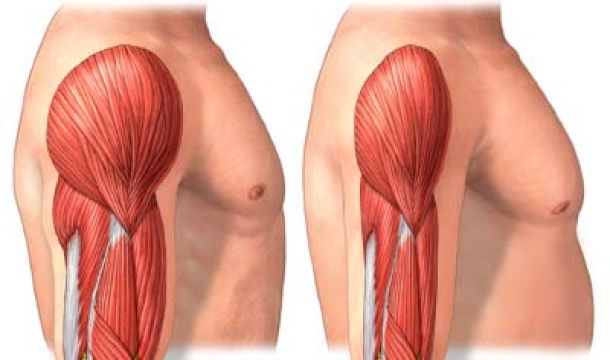
Unlock the Power of Cognitive Behavioral Therapy (CBT): Elevate Your Practice!

MI Days-2.0

Join us for "Case Management (CM) Days" Spring 2024!
Get Your Free Article to...
"Becoming An Evidence-Based Organization (EBO)
Five Key Components To Consider" by David L. Myers, PhD.
Would You Like To Set Your Leadership Apart from The Typical?
"Becoming An Evidence-Based Practitioner (EBP)
How To Set Yourself Apart" By Mark M. Lowis, MINT
Would You Like To Set Your Yourself Apart from The Typical Practitioner?
Masterclass Options
We offer a Masterclass & Certification for LEADERS and PRACTITIONERS. Which are you interested in exploring?
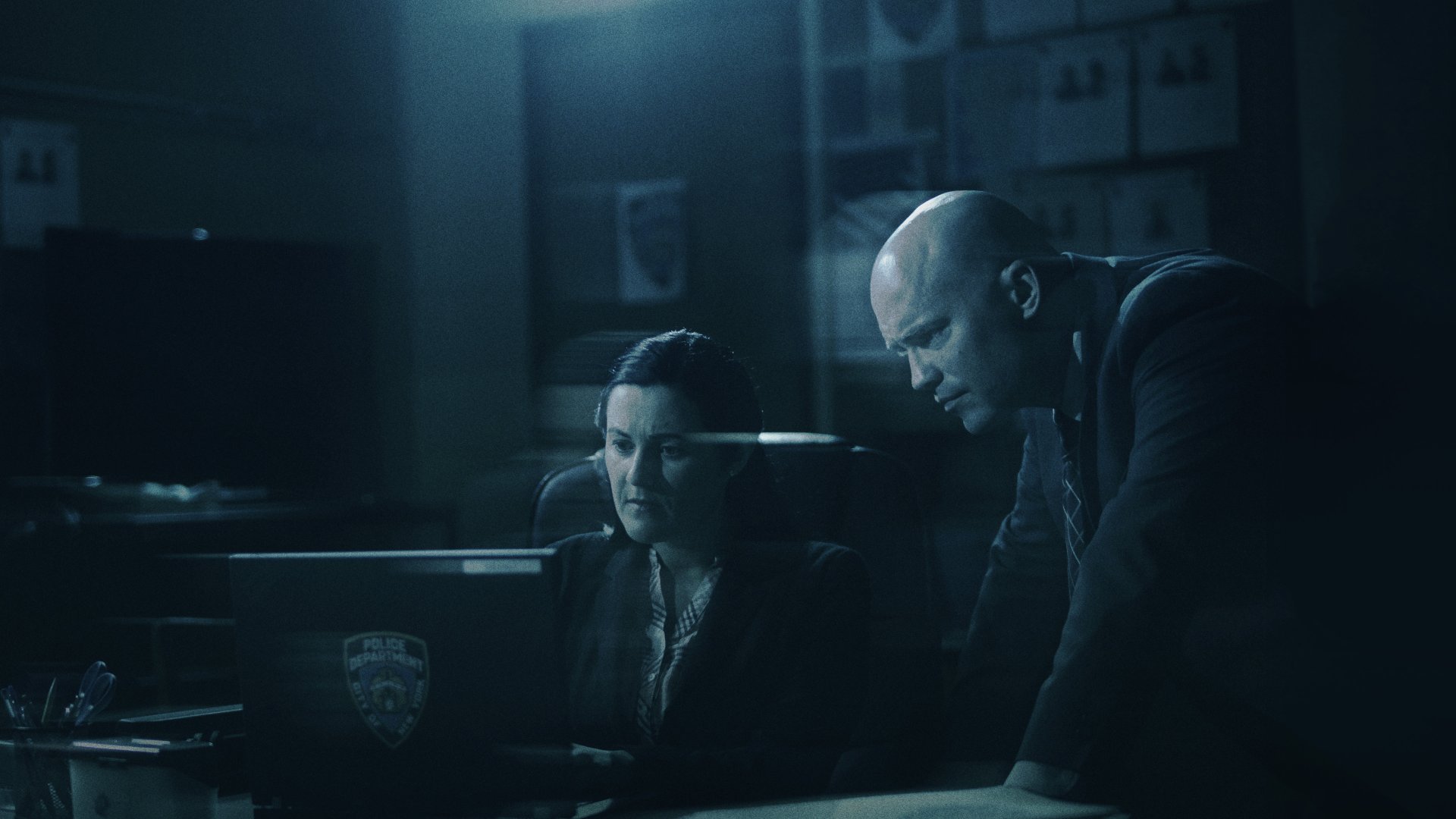
Stream ID Live
Never miss a mystery.
Sign in with your cable subscription
Watch Free Series
On the case with paula zahn, see no evil, bride killa, i married a mobster, deadline: crime with tamron hall, homicide hunter: lt. joe kenda, til death do us part, jared from subway: catching a monster, the hillside strangler: mind of a monster, twisted sisters, the playboy murders, unusual suspects, trending on id, evil lives here, mean girl murders, lethally blonde, new york post reports: off the record, is o.j. innocent the missing evidence, murder in the heartland, continue watching, new episodes.
S8 E8 He Shot Me!
S1 E4 The Fall of Aubrey Gold
S2 E4 Queen vs. Princess
S15 E8 He Used a Chainsaw
S27 E6 A Murder at Paradise Ranch
S9 E4 Spring Breaking Up
Bail Jumpers
S1 E12 Iguanas, B-ball and Silence
S1 E11 Shoplifting, Philosophy, Death
S8 E7 Psycho 1
S1 E3 Dirty Dancing
My Episodes
Stream the first season free, crimes gone viral, american detective w/ lt. joe kenda, evil lives here: shadows of death, i (almost) got away with it, murder comes to town, a crime to remember, signs of a psychopath, undercover underage, in pursuit with john walsh, where murder lies, link your tv provider to unlock thousands of episodes from the discovery family of networks..
Network availability may vary with your TV package.

Do Not Sell or Share My Personal Information
For california, colorado, connecticut, virginia and utah residents only, allow sale, sharing or use of my personal information for targeted advertising.
If you switch this toggle to “no,” we will not sell or share your personal information with third parties for advertising targeted to this browser/device. Please see our Opt-Out Form for additional preferences.
Global Privacy Control (GPC)
When a GPC signal is not detected, we sell and share your personal information unless you toggle "no" above.
Cookie List
- Login or Sign up
Study Argues that Conjugal Visits Can Reduce Number of Prison Rapes
Researchers at Florida International University contend that states where sexual intercourse between prisoners and their visiting spouses is allowed have fewer rapes and sexual assaults than states where conjugal visits are prohibited, El controversial finding that disputes the theory that sexual offenses are solely crimes of power rather than a means asexual release.
"Our findings propel the idea that sexual violence can be attenuated given appropriate policy initiatives." according to the January 2012 report. "The Effect of Conjugal Visitation on Sexual Violence in Prison." from FlU researchers Stewart D'Alessio, Jamie Flexon and Lisa Stolzenhem,
The FIU study was conducted over a three-year period. from 2004 to 2006, in the states that allowed prisoners conjugal visits at the lime: California, Mississippi, New Mexico, New York and Washington. While sexual violence occurred in states that prohibit conjugal visits at a rate of 226 per 100,000 prisoners, it occurred nearly five times less frequently in the live stales that allow conjugal visits – 57 per 100.000 prisoners.
Thus "inmate-on-inmate sexual offending is much less pronounced in states that allow conjugal visitation." according to the FIU studs.
According to a report from the federal Office Justice Programs, more than 60.000 prisoners nationwide (4.5% of all state and federal prisoners) were sexually victimized in 2007. In some states' prisons, the number of victims of sexual assault that year approached or exceeded 20%. A Bureau of Justice Statistics (BJS) national survey published in August 2010 estimated that approximately 88.500 then-incarcerated adults had been sexually victimized while in prison or jail.
The effect of conjugal visits in reducing sexual assaults in prison should force more states to consider allowing conjugal visits, according to researchers. Conjugal visits have other positive effects. the study said, They help improve, for instance, the functioning of marriages by maintaining a prisoner's) role as husband or wife improve (he (prisoner's) behavior while incarcerated, counter the effects of prisonization, and improve post-release success by enhancing the (prisoner's) ability to maintain ties with his or her family."
"Additionally," the study said, "because conjugal visitation is reported to reduce homosexual activity and because AIDS is often spread by homosexual activity, conjugal visitation may help to attenuate the spread of AIDS in prison."
Researchers volunteered that their study had certain limitations especially that "instances of sexual offending" in prison are underreported and. therefore, there certainly could have been more cases of sexual victimization in states that allow conjugal visits than their data concluded.
Nevertheless. the findings have her policy implications, according to the study programs, researchers argue, "should he geared to view sexual offending as a sex crime instead of solely as a crime of power." Such programming, the study says, could reduce recidivism.
"The harm caused by rape and other forms of sexual violence," researchers concluded, "reverberate through our lives, homes and communities. Additional policy initiatives directed at extinguishing sexual violence, which appears to the undertaken by (prisoners) to satisfy their sexual urges need to be identified."
Source: Florida International University. Department of Criminal Justice: "The Effect of Conjugal Visitation on Sexual Violence in Prison," American Journal of Criminal Misfire, February 2012.
As a digital subscriber to Prison Legal News, you can access full text and downloads for this and other premium content.
Subscribe today
Already a subscriber? Login
More from these topics:
- Sentencing Project Finds “Important Inroads” Against Mass Incarceration, Racial Inequality Behind Bars , April 1, 2024. Racial Discrimination , Statistics/Trends .
- Parole and Probation Accused of Driving Prison Growth , April 1, 2024. Commentary/Reviews , Statistics/Trends , Probation, Parole & Supervised Release , Conditions of .
- BOP Pays $40,000 to Prisoner Sexually Assaulted at Florida Lockup by Guard, Who Must Pay Her $1 Million , March 1, 2024. Staff-Prisoner Assault , DOC/BOP misconduct , Prison Rape Elimination Act .
- Virginia Leads the Nation in K-9 Attacks on Prisoners , Jan. 1, 2024. Racial Discrimination , Statistics/Trends , Dogs .
- Private Prisons Hold Almost 100,000 Prisoners, 8% of Total U.S. Prison Population , Jan. 1, 2024. Private Prisons , Commentary/Reviews , Statistics/Trends , Databases .
- 153 Killed in Custody in Salvadorian Gang Crackdown , Jan. 1, 2024. Gang Policies , Commentary/Reviews , Prison/Jail Murders , Statistics/Trends , Databases , International Law , Prisoners-International , Wrongful Death , Excessive Force (Wrongful Death) .
- Another Report Verifies That Prison Deaths Soared During COVID-19 Pandemic , Jan. 1, 2024. Commentary/Reviews , COVID-19 , Statistics/Trends , Databases .
- New York Adding Names to Tombstones of Dead Prisoners , Dec. 1, 2023. Visiting , Extended Family Visiting , Family .
- South Carolina DOC Investigates Jail After 30 Detainee Injuries, Two Escapes and Five Guard Arrests , Nov. 15, 2023. Sexual Assault , Staff-Prisoner Assault , Escapes , Guard Brutality/Beatings , Acceptance of Responsibility , Relevant Conduct .
- Women Behind Bars, by the Numbers , Nov. 15, 2023. Sexual Assault , Wrongful Death , Effects of Mass Incarceration .
Official websites use .gov
A .gov website belongs to an official government organization in the United States.
Secure .gov websites use HTTPS
A lock ( Lock A locked padlock ) or https:// means you've safely connected to the .gov website. Share sensitive information only on official, secure websites.
Federal Bureau of Prisons
General visiting information.
Make sure your visit will be a success by carefully following these four steps.
Discover or confirm the whereabouts of the inmate you would like to visit.
Before you can visit you must be placed on the inmate's approved visiting list.
Review all visiting rules, regulations, and procedures before your visit.
Find out when you can visit and get directions to the facility.
Locate the inmate
Sometimes an inmate may be moved to a different facility so that they can benefit from unique programs offered at that location. They might also be moved to receive treatment for a medical condition or for security concerns. Therefore, the first step in planning your visit should be to determine where the inmate is currently housed.
Please verify you are a human by entering the words you see in the textbox below.
To visit, you must be pre-approved.
You can only visit an inmate if they have placed you on their visiting list and you have been cleared by the BOP.
- An inmate is given a Visitor Information Form when he/she arrives at a new facility.
- Inmate completes their portion of the form and mails a copy to each potential visitor.
- Potential visitor completes all remaining form fields.
- Potential visitor sends the completed form back to the inmate's address (listed on the form).
- We may request more background information and possibly contact other law enforcement agencies or the NCIC
- The inmate is told when a person is not approved to visit and it is the inmate's responsibility to notify that person.
Who can an inmate add to their visiting list?
- Step-parent(s)
- Foster parent(s)
- Grandparents
- No more than 10 friends/associates
- Foreign officials
- Members of religious groups including clergy
- Members of civic groups
- Employers (former or prospective)
- Parole advisors
In certain circumstances such as when an inmate first enters prison or is transferred to a new prison, a visiting list might not exist yet. In this case, immediate family members who can be verified by the information contained in the inmate's Pre-Sentence Report, may be allowed to visit. However, if there is little or no information available about a person, visiting may be denied. You should always call the prison ahead of time to ensure your visit will be permitted.
Be Prepared
You should be familiar with all visiting rules, regulations, and procedures before your visit.
The following clothing items are generally not permitted but please consult the visiting policy for the specific facility as to what attire and items are permitted in the visiting room:
- revealing shorts
- halter tops
- bathing suits
- see-through garments of any type
- low-cut blouses or dresses
- backless tops
- hats or caps
- sleeveless garments
- skirts two inches or more above the knee
- dresses or skirts with a high-cut split in the back, front, or side
- clothing that looks like inmate clothing (khaki or green military-type clothing)

Plan your trip
- the prison location
- the prison type
- inmate visiting needs
- availability of visiting space
The inmate you plan to visit should tell you what the visiting schedule is for that prison; however, if you have any questions please contact that particular facility .
General Visiting Hours
Camp general visiting hours, fsl general visiting hours.


An official website of the United States government, Department of Justice.
Here's how you know
Official websites use .gov A .gov website belongs to an official government organization in the United States.
Secure .gov websites use HTTPS A lock ( Lock A locked padlock ) or https:// means you’ve safely connected to the .gov website. Share sensitive information only on official, secure websites.
NCJRS Virtual Library
Conjugal visiting in united states prisons, additional details, no download available, availability, related topics.

- Login or Sign up

Conjugal Visits in Prison Discourse - Is It Even an Offender Rehabilitation Option in Africa
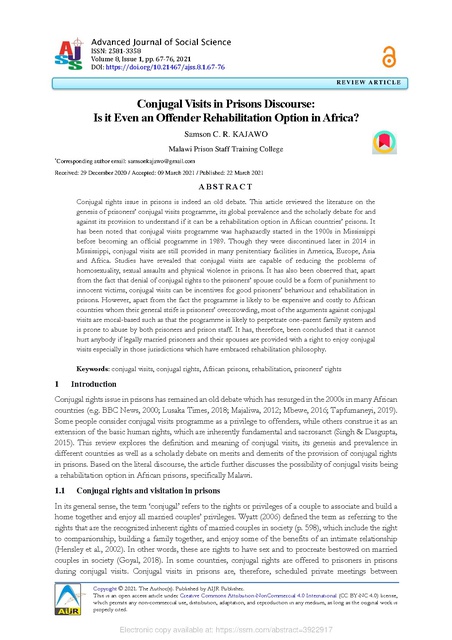
Inmate Search & General Jail Guide
Inmate Search | Inmate Mail | Inmate Phones | Orca Lookup & More
How To Visit An Inmate In Prison | All Your Questions Answered
Table of Contents
Visiting an inmate for the first time is one that is filled with mixed feelings of what to wear, what form of identification to present to the guards, what to bring along as a gift, if kids are allowed in, and other random thoughts like that.
With all these thoughts popping up in your head at the same time, you may end up more confused and frustrated. Not to worry!
This guide contains what you need to know when visiting an inmate for the first time, and perhaps will provide answers to all your confusions.
Types Of Prison Visitations
There are several types of visitation for inmates. Visitation ranges from video visitation, non-contact/telephone visitation, and contact visitation.
Prison Video Visitation
Video visitation is the one that’s mostly being used today. Just like the way you’d use Skye, video visitation can be done even from the comfort of your home.
No Contact Jail Visitation
Non-contact/ telephone visitation is one that involves sitting behind a glass barricade while talking with your inmate on the telephone.
Full Contact Prison Inmate Visitation
Contact visitation is the most common and often preferred by visitors. Here, you are able to sit with the inmate and talk for a short period of time. It even gives you the opportunity to even make contact with your ok inmate, however there’s a limitation to that.
Forms of contact usually allowed include a brief hug, hello, and goodbye. Holding of hands is often frowned at by prison officials.
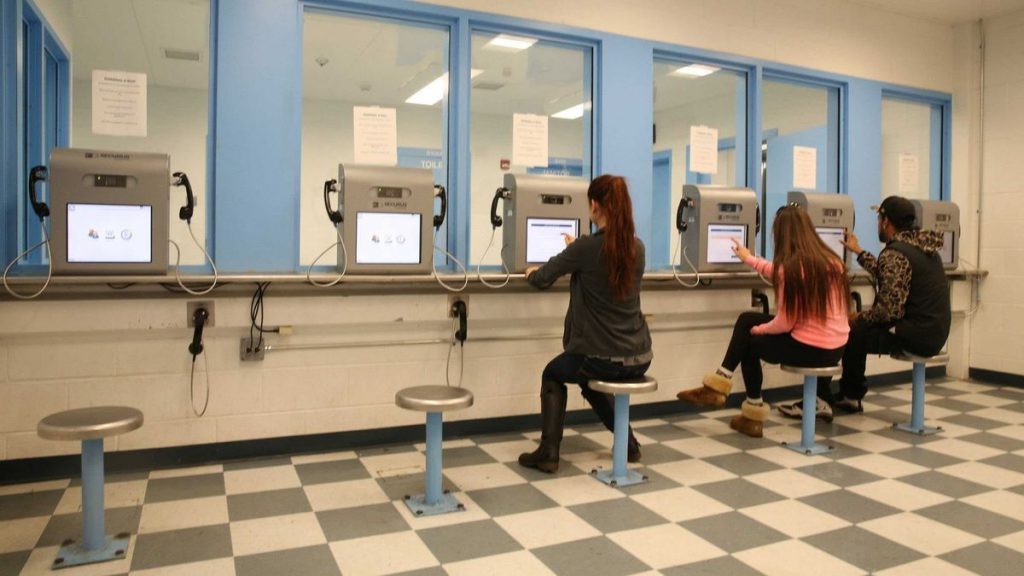
What To Do Before You Visit A Prison
It is important that before you are granted access to visit your inmate, you must have previously been in contact with him/her. The prison has a visitors list that contains the friends and family members that are allowed to visit.
Some facilities provide inmates a list containing slots for 10 visitors that they wish to include. As such, the inmates must have all the details of the visitors he intends to include In the list, which include: the visitor’s full name, the visitor’s address, the phone number, and at times more other information about the visitor.
So if your inmate does not know all this information, you can send him a mail containing a letter that stipulates your information.
Other facilities may request all prospective visitors of the inmate to fill out a visiting application (some only give out this form based on the wish of the inmate).
How To Apply For A Visitation At The Prison
The visiting application is given to visitors who intend to pay a visit to inmates, however not all facilities will request that you fill a visitors application (most facilities do anyway).
The visiting application is more like a questionnaire that contains a portion in which you are required to fill out your name, address, and questions that seeks to find out if you are a convicted felon, or if you’ve been incarcerated or worked in the department of corrections.
Proceed to answer, fill in your names and answer the questions as truthful as you can because the information provided will be used to perform a background check up on you.
The findings will determine if your visit will be approved or denied.
What Can Make You Denied From Visiting A Friend In Jail?
- If the information provided in the visiting application is false.
- If you’re a convicted felon.
- If you’ve previously served time in a correctional facility, or have worked in the department of corrections.
- If you have outstanding warrants.
- If there’s a protective order against you or the inmate.
- If you are seen as a threat to security at the facility.
- If you are on PTI, probation, or parole (although some exceptions can be made to this).
- If you’ve already filled a visiting application to another inmate at the facility.
You will only know if your visiting application is approved or denied when your inmate tells you, most institutions will not inform you. Therefore, you must ensure a constant communication with your inmate to ascertain the status of your application.
However, if you’re denied visiting privileges, you have a choice to appeal the decision. Only make sure you file for appeal within the stated time frame.
How To Prepare For A Prison Visitation
If your visiting application is approved by the facility, check the schedule of the visitation hours specified by the institution.
You check visiting hours for some facilities on their website, and be sure to double check if possible, as visiting hours may be changed at any time or even cancelled without notifying you.
A correctional facility may cancel visiting if the facility goes on a lockdown, if an inmate has escaped, or due to reasons known to the facility. An inmate may also be denied visiting privileges if they’re confined in solitary.
Once you are sure of the visiting hours, ensure to take along every needed form of identification on the day you intend visiting your inmate.
Although in most cases you only need your valid state issued identification card or drivers license, some facilities however vary in the type of identification they accept.
Visiting A Jail As A Minor Or With A Minor
If you’re visiting with a child or minor, the facility will require you to first fill out a special visiting with minors authorization form.
When such a minor is above 14, he/she would have to come along with a school issued photo ID or birth certificate before they’re allowed to visit.
Also, minors are not allowed to visit inmates alone, as it is required that they must be always accompanied by a parent or guardian. Inmates who were incarcerated for crimes against a child cannot have access to visits by minors.
Small children or babies may also need to come along with their birth certificate to be allowed to visit, but it is not a must in all cases. When visiting with children, try as much to control them because they’re found causing a nuisance, you can get kicked out from the visiting area.
How To Dress For A Prison Visitation
Every correctional facility has a dress code for visitors thus, if you’re visiting any, ensure to put on the specified dress code else you’ll be refused from visiting.
Here are some things to keep in mind when selecting a dress for visiting inmates:
- Do not put on a dress that resembles the inmate’s clothes in design or color, and that of the staff.
- Do not visit in medical scrubs or any sort of uniform, as this may pose a threat to the facility’s security.
- You must dress in shirts and put on shoes.
- Clothes that expose sensitive parts of the body are prohibited.
- See through fabrics are not allowed.
- Sleeveless shirts are prohibited.
- Shorts and skirts that are above the knee or those with slits are prohibited.
- Offensive imprints or languages on clothing is prohibited.
- Tight clothing which include spandex, leggings, tights are prohibited.
- Jewelries are also prohibited, so keep that in mind when dressing.
Sometimes, it is up to the prison guard to scrutinize which kind of dressing is allowed into the prison. To avoid being sent back because of a violation in dress code, you can come with a change of clothing just in case.
Getting Searched At A Prison During Visitation
It is advisable to arrive a few minutes early to the facility when visiting, as you may be required to fill out more paperwork (you may get into trouble if you arrive too early though).
Keep in mind that you’ll be searched from your arrival at the parking lot, your car will also be searched by the prison guards or even security dogs for any incriminating item or one that violates the rules of the facility.
Even when you enter the facility, expect to be searched again usually by pat down or with a metal detector. And If you refuse to be searched, you’ll be banned from visiting.
There are even cases where visitors must consent to strip search before they’re allowed in, but if you’re not comfortable with this, it doesn’t mean you’ll be refused visitation.
Strip searching was mainly done to detect drugs hidden in the body that scanners couldn’t pick. However, it is now a thing of the past as security dogs are used by facilities instead.
What To Take With You On A Prison Visitation
This varies from one facility to another. Some facilities may provide lockers that can be rented for about a quarter to store your belongings in, others do not.
You’re only allowed to bring in your ID, single car key, eyeglasses (if any), some change for use at the vending machine, as you may need it to buy snacks for your inmate while you talk.
If you’re visiting with a baby, you may be allowed to come with a feeding bottle and a change of diaper. Items such as medications, cigarettes are considered illegal, as you can be banned if found in possession of any of these, and possibly charged.
Questions About Visiting A Friend In Jail
If you have about visiting an inmate that was not answered in this article, you can post in the comment section below and we’ll do our best to provide answers to such questions.
Can you kiss on prison visits?
You can kiss during prison visitation at a low risk community prison, however, in many other centres, the case is different. Kissing on a prison visit depends on the type of prison facility where your loved one is incarcerated.
These days, most facilities do their best to prevent direct contact in order to avoid smuggling of drugs and other prohibited substances. If you intend to kiss your loved one, then make sure the rules in the facility permit you to do so.
How long does it take to get approved for prison visitation?
Most prison visitations are approved on a first-come first-served basis. Your request for a prison visit can be approved in less than a week, however the visitation date may vary.
You need to put in every prison visitation request on time so as to factor in the time it may take to process other requests submitted before you, and to give the prison operations director enough time to make adequate preparations for the security and safety of you and other visitors.
What is the process of visiting someone in prison?
For most prisons, you will need to fill out a visitation request online, and submit it for them to get started on processing your visitation request. FOr many others, you will need to schedule a visit through the visitation centre.
How do I visit someone in jail in Canada?
Most prisons in Canada accommodate visits through a visitation centre. You will need to schedule an appointment through the visitation centre for your request to be processed.
Can you wear jeans to visit an inmate?
Members of the public are allowed to wear jeans or any form of clothing to a prison visitation. Notwithstanding the type of clothe you put on, highly sophisticated infra-red sensors will always be at major entry points to scan you for prohibited items.
How many visits do prisoners get a week?
Prisoners are allowed to get as much visits as the prison can accommodate. Most prisons tailor their activities to only accept a number of visitors per day and once this number is reached, other visitation requests are pushed on to the next available day.
Are conjugal visits monitored?
Conjugal visits are usually monitored for the safety of both the inmate and the visitor. A highly trained staff will monitor the activities that happen during the visit to make sure that the visitation conforms with acceptable practices.
Conjugal visits were designed as a means to preserve families and give incarcerated people the opportunity to procreate even while in prison. These days, there are not many prison facilities around the world that still allow conjugal visits from an inmate’s registered spouse.
Can you swear in a letter to an inmate?
If a letter to an inmate contains a swear word, it will be given a second review to determine what to do with it. The level and context of the swearing in a letter will determine if it will be handed over to the inmate, or confiscated for vulgarity.
What happens to your clothes when you go to jail?
When you go to jail, your clothes are locked up in your property. This is a little lock box assigned to all inmates where clothes, keys, wallets, shoes and received books/letters are kept.
How should I dress for a prison visit?
While preparing for a prison visitation, wear something that you feel very comfortable in. Do not put on very oversized clothes that may put you on the spotlight and have the guards second-guessing if you;re hiding something underneath.
Do Death row inmates get visitors?
Yes. Death row inmates are allowed to receive visitors just like any other inmate. Friends and family, loved ones, lawyers, human rights organisations and other religious societies are allowed to visit inmates on death row.
Can you wear a bra in jail?
Inmates are given adequately sized bras in jail to put on. While these bras are issued, it is however the responsibility of the inmate to put them on.
Can you hug an inmate during visitation?
Hugging an inmate can be allowed in certain incarceration facilities, but in some others, a no contact law is usually enforced and must be adhered to.
Your ability to hug a loved one during a prison visitation will depend on the laws guiding that particular institution. Make sure you check in with the regulations before you attempt to hug an inmate.
Can you wear your wedding ring in jail?
A wedding ring is usually considered a sentimental item and thus, inmates are allowed to wear their wedding rings after they are vetted by the security department.
If an inmate poses some degree of threat, or is seen capable of inflicting bodily harm or injury through a ring, then they are denied the ability to wear their wedding ring while in prison.
Can you FaceTime inmates?
It is not possible to facetime with inmates. Electronic gadgets are prohibited in prisons and any inmate found with a mobile phone will face very serious charges which could increase their sentence.
What can you bring to a conjugal visit?
If you’re approved for a conjugal visit, you will be given a list of items that are permitted, and a list of items that are prohibited.
Breaking the law during a conjugal visit may lead to very serious consequences for both the visitor and the inmate.
What is a conjugal visit in jail?
A conjugal visit is a visitation that allows an inmate have some private time for intercourse with a listed spouse. This type of visitation is allowed to help families cope with their intimate desires.
Why are conjugal visits not allowed?
For most facilities, conjugal visits are denied because they pose a great risk to the operations of the prison facility. Most times, prisoners use conjugal visits as an opportunity to smuggle prohibited items like drugs and weapons into the prison facility.
Can you get sperm from an inmate for artificial insemination?
It is impossible to get a sperm from an inmate for artificial insemination. This is a practice that has not been approved in any prison facility. If you intend to conceive, you can request for a conjugal visit if it is allowed, or have intercourse with your partner if they are ever released to attend a funeral or family event.
One Response
- Pingback: How To Encourage And Support Friends In Prison - Prison Life
Leave a Reply Cancel reply
Your email address will not be published. Required fields are marked *
Save my name, email, and website in this browser for the next time I comment.
Jails around Wisconsin forgo in-person visits for video calls. How is this affecting those incarcerated?

HOBART – From her dining room table on an evening in February, Stacie Bryant logged onto her tablet to see her son for the first time in nearly four weeks.
Tyler Bryant, 23, is currently serving 90 days at Oconto County Jail for violating his probation.
Holding Tyler's 15-month-old son, Milo, Stacie Bryant gave her son a smile and asked how he was doing. Tyler filled her in on his schedule, recent happenings and when he would get clippers to shave his facial hair.
"I missed seeing him," Stacie Bryant said after the video call. "He was coming over here almost every day."
Virtual visitation, for many families of people in jail, is a helpful tool for its flexibility and accessibility. But as it is becoming commonplace, more and more jails in Wisconsin are making video visits the only option, entirely eliminating traditional in-person visits.
The Post-Crescent contacted every jail in the state to gather information about their visitation policies. An analysis of the data found 46 out of the state's 72 jails — about 64% — have no option for people to do visits with friends and family in person, instead only offering contact through a video screen. And more jail administrators plan to follow this trend, with many stating that the pandemic expedited their decision to go all-virtual.
While video visitation has its benefits, formerly incarcerated people, experts and people who have visited friends and family in jail say the inability to be within physical proximity of loved ones takes a toll on mental health.
The American Bar Association's standards state that video visitation should not be a replacement for in-person visits with people confined for more than 30 days — around the average length of stay in a county jail.
But depending on court proceedings, people can be held in jail for years. In Brown County Jail, the longest stay of a recent prisoner was close to seven years — from May 2016 to February 2023, according to Brown County Jail Administrator Heidi Michel.
And unlike in prisons, most people in jail are there for a crime for which they have not been convicted.
Jennifer Verderami, a housing advocate with ESTHER , an interfaith social justice organization that is the Fox Valley affiliate of WISDOM , said it's more challenging to assess the emotions of a person through a video screen than when sitting across from them — even through a glass partition.
Her first experience with video visits was when the pandemic struck while she was incarcerated at Robert E. Ellsworth Correctional Center, a minimum-security women's prison in Racine County.
“There's a different quality even when there's a partition separating you, knowing there's only inches between you and your loved one," she said.
Video visits lack physical support, formerly incarcerated people say
Visitation is extremely important for the mental health of people who are incarcerated, particularly those serving lengthy sentences. According to the DOC's website , "research shows maintaining strong family ties can have a positive impact on an offender's success in completing treatment and other programs during incarceration, as well as their chances for success after they are released."
In-person contact visitation, where incarcerated people are allowed to talk to, play games with and hug their loved ones is offered in most of Wisconsin's prisons. But in county jails, where state statutes include fewer guidelines for how visitation should take place, non-contact visits are the norm, either behind a glass partition or by video.
Still, people who have been on both ends say there is a difference between a visit through a glass divider and a visit through a computer screen.
"You can sense the proximity. On a video screen, that does not exist," said Roy Rogers, who was incarcerated for 28 years until his parole in 2021.
Since his release, Rogers has become an advocate for jail and prison reform, working as a pre-entry liaison for The Community and serving on the board of directors for the Wisconsin Justice Initiative .
"With the divider behind a window thing, at least you can see the full human expression — you know, the nuances of emotion that you cannot catch through a video visit," he said.
Wanda Bertram, a communication strategist at the Prison Policy Initiative , a national nonprofit criminal justice think tank, said it's also harder for loved ones to assess the health and well-being of a prisoner through a video screen, as opposed to sitting a few feet away.
"Families have found that this really diminishes the quality of connection that they're able to get," she said.
A spokesperson for the company that owns Securus Technologies , the video visitation system used at Brown County Jail and a dozen other Wisconsin jails, said the video service "acts as a supplement for in person-visits" but is not intended to replace them.
Despite this, most jails in Wisconsin that have eliminated in-person visiting options have no plans to bring that option back, various county jail administrators said.
Meanwhile, some jails around the country have entirely eliminated the infrastructure needed for in-person jail visits after adding video visits. In Brown County, for example, Michel said the jail switched to all-virtual visits because there were no in-person visitation booths included in a jail renovation project.
Video visits can be expensive and low quality
Wisconsin jails offer video visits free to people who use the jail's on-site video kiosks. But those who choose to visit through a remote device are charged a fee.
Prices differ based on what company the jail contracts with. For example, remote visits with jails that use Securus range from $5.95 to $12.95 for a 20-minute remote visit, according to the spokesperson for Aventiv, the parent company of Securus. In Brown County Jail, that's $7.50 a visit. Other telecommunications companies charge by the minute. In Outagamie County Jail, which uses ViaPath Technologies , a remote video visit costs 25 cents a minute.
Tyler Bryant served time at both Brown County Jail and Oconto County Jail. The Bryants said the two jails' visitation services were a night-and-day difference.
The first time Tyler's girlfriend used Brown County Jail's free on-site video kiosks to visit Tyler, she had issues logging on and could not find anyone around to help her.
When she came back to try again another day, she was able to get the video to work, but the quality on both ends was poor, Tyler Bryant said.
"That sucks. You can't even see the background — like, it's all pixelated," he said. "They completely blur everything out, unless you're two inches away, and then you can see like half of the face."
That was with Securus. Video visits at Oconto County Jail, which uses the company CIDNET , were much clearer, Stacie Bryant said.
Securus and CIDNET are the two most widely utilized video visitation systems in Wisconsin's jails. A handful of others systems are also common, including ViaPath, the system in place at Outagamie County Jail.
Autumn Cross, a Combined Locks resident who visited a friend in Outagamie County Jail about once a week for three months before he went to prison, said the remote video calls she did often had blurry video, delayed audio and unreliable connection.
"Video visits always have a lot of the connection issues where you can't hear them, or they can't hear you," Cross said. "It's not always guaranteed that you're going to have your video visit, because you can get disconnected and then sometimes you're not able to call back."
For Verderami, who served nearly five years in prison before her release last year, video visitation was free, due to the pandemic. But the visits were emotionally challenging, particularly those with her teenage son or her grandchildren.
"It actually got to the point where I didn't want to even do the video visits anymore because it made me so sad," she said.
Verderami said if video visits were not free and her only access to video visits was by paying, she would not have had any visits during that time.
Proponents say virtual jail visitation offers flexibility and savings for families
Many jails that only offer virtual visitation point to its benefits, like the flexibility to visit from home and increased opportunities for visits.
Outagamie County Jail switched to virtual visitation in 2020 and never went back. Jail Administrator Dave Kiesner said the jail had already been planning to transition to video visits only, but the pandemic expedited that process.
People in jail "have much more ability to see and talk to people now with this new system than they've had before," Kiesner said. "When we had in-house visits, it was just twice a week. ... It was like on a Tuesday at 10 o'clock and maybe a Saturday at 4 o'clock, and that was only time you could come visit. Now you can set up for whatever works for you at home."
Many county jails in the state also say video visits reduce the risk of contraband getting into the jail. However, it's not clear if there is data to back this up. Kiesner said Outagamie County Jail does not track contraband incidents specifically tied to visitation.
Michel, the administrator at Brown County Jail, said video visitation is beneficial for people who live too far to regularly visit with loved ones. By paying $7.50 for a 20-minute visit from home, they can save money on gas and time.
But for about a quarter of Wisconsin's jails, it doesn't need to be one or the other.
Lt. Brad McCoy of the Waushara County Sheriff's Office said that when Waushara County Jail added a video visit option in 2023, it did not eliminate its in-person option. McCoy said he does not think a video call has the same impact on a prisoner's mental health as actually seeing a loved one in-person — even behind a glass partition.
"I still see benefits in having in-person visits," he said.
And 16 other Wisconsin jails, including Madison's Dane County Jail, offer both types of visitation.
"We still like to do the in-person, because it’s in-person. It’s different than looking through a camera at someone," said Lt. Gary Vandivier of the Dane County Sheriff's Office.
Jails sometimes have incentives to eliminate in-person visiting options
The Prison Policy Initiative has published multiple studies about telecommunications-related issues in jails and prisons across the country. Betram said their research found that jails have financial motivations to eliminate in-person visitation.
For one, video visitation requires fewer staff members to supervise, a major benefit for jails with a shortage of staff.
Additionally, Bertram said that in many contracts between video providers and jails, the county receives either a lump sum payment or a percentage of the total revenue from video calls.
Both Brown County Jail and Outagamie County Jail receive a commission from telecommunications services. However, Michel said that in Brown County, none of the profit made off of video visitation goes to the county; it goes into an "inmate welfare account," which is used to fund items and programs for people in jail, like new mattresses or the county's canteen ministry program.
"This is not a product that jails and prisons have necessarily gone hunting for. It's something that the companies, which tend to already have relationships with jails and prisons by providing phone calls or other services like that, will advertise pretty aggressively," Bertram said.
Bertram said some of these contracts have in the past stipulated that county jails must eliminate or restrict the in-person visiting option. She said she has seen those stipulations less often in recent years. Neither Brown County Jail's nor Outagamie County Jail's most recent contracts give requirements for jails on in-person visits.
According to a 2015 report from the Prison Policy Initiative , Securus was the only company of those studied that explicitly required jails to stop offering an in-person visitation option. But the spokesperson for Aventiv, the parent company of Securus, told the Post-Crescent that Securus "never impose(s) any prohibition on in-person visits."
No other telecommunications companies in Wisconsin jails — including ViaPath, CIDNET, ICSolutions , Reliance Telephone or Turnkey Corrections — responded to questions about their contracts' visitation guidelines.
The transition to video visits as the norm is a fairly recent shift in Wisconsin; most county jails began implementing the new technology just in the last few years. Four in the state, however — including Milwaukee County Jail — stopped video visit services as early as 2003 and 2004.
Rogers said he believes the transition to video visitation in jails is another step of what he sees as decreasing outside contact in Wisconsin's jails and prisons in recent years.
As another example, he pointed to the Department of Correction's switch in 2021 to providing people in prison with photocopies of mail rather than the original papers — a move intended to decrease drugs sneaking into prisons.
"The smell and the scent of the envelope to come from moms or a girlfriend, they'll never be able to smell that anymore, you know? Just to see, your kid drew this picture, and you know, it's smelling like jelly, or those Jolly Ranchers that he likes, you know, and some of that got on the envelope or the letter. You'll never be able to experience that again in Wisconsin (prisons)," he said.
For people in jails and prisons, Rogers said, any connection to their support system is essential for rehabilitation and a future reintegration into society. He said he worries about a total shift to video visits in jails.
"When you're in a county jail, for the most part, if you turn out to not be found innocent of what you've been held for, the last memory you will have of touching and holding your loved one will be that moment before you were arrested," he said. "And, like, even though you're sitting in that county jail and you're innocent until you're proven guilty, you've already been deprived of your human relationship, and you have not been convicted of a crime."
Green Bay Press-Gazette reporter Danielle DuClos contributed to this report.
Kelli Arseneau can be reached at 920-213-3721 or [email protected] . Follow her on X at @ArseneauKelli .
latest in World News

Locals stunned after 500 dead horses found in creek bed:...

Proposed train station that resembles a massive sanitary pad...

Netanyahu dismisses calls for restraint over Iran attack, vows...

Senior Hezbollah field commander killed in Israeli drone strike...

Historic UAE storm may have been self-inflicted by cloud seeding,...

Magnitude 6.4 earthquake rocks southern Japan

Billionaire presumed dead may be alive in Moscow and living with...

Squatters take over Marco Pierre White's old London restaurant...
Joran van der sloot lawyer releases prison soccer video to show he’s ok after alleged inmate beatdown.
Thanks for contacting us. We've received your submission.
Joran van der Sloot’s lawyer shared a video with Fox News Digital that showed his client in apparent good health after disputed reports that the man who killed American teen Natalee Holloway and Peruvian heiress Stephany Flores suffered a beatdown behind bars.
In the 41-second clip provided by his Lima-based attorney, Maximo Altez, van der Sloot and his teammates on “La Naranja Mecanica” – Spanish for “The Clockwork Orange” – follow several other prison teams into a gymnasium.
At 6 feet 5 inches tall, van der Sloot towers over everyone else in the room, holding his hand over his heart and grinning as he enters, wearing a blue tracksuit and a newsboy hat.
Altez has denied reports of a two-on-one prison assault against van der Sloot as “fake news” after the 36-year-old killer purportedly went to a prison infirmary for treatment and was said to be a marked man.
“He’s fine,” the lawyer told Fox News Digital.

A spokesperson for Peru’s National Penitentiary Institute told the Post last week that two men attacked the Dutch national in prison and that he was treated for cuts and bruises.
He was not facing disciplinary action because the assailants were the instigators.
“A lot of people want him dead,” the paper quoted the unnamed official as saying.
Peru’s Interpol chief, Col. Luis Quiroz, told Fox News Digital that prison officials he spoke with had no information about an alleged assault on van der Sloot.

A former inmate who did time with van der Sloot during his brief detention in Alabama last year told the Post that the killer is an arrogant “d–chebag.”
“He walks around jail like he’s the boss, demands what he wants, treats other guys like s—,” Emil Quinones told the paper. “He made a lot of enemies because he’s such an a–hole.”
Van der Sloot is serving his multiple sentences in Peru’s mountaintop Challapalca prison, a place Altez previously said he hates so much he was willing to talk to prosecutors in the US in connection to federal extortion charges against him.

Even so, he is granted conjugal visits there with multiple women for his mental health and rehabilitation under the country’s constitution.
It was not immediately clear how van der Sloot’s team chose its name, “The Clockwork Orange,” but a 1971 Stanley Kubrick movie with the same title is about the botched attempt at rehabilitating the leader of a gang of violent rapists.
Van der Sloot finally admitted in October to killing Holloway with a cinder block on an Aruba beach in 2005 as part of the extortion and fraud case in which he tried to shake down the victim’s mother for $250,000.
He murdered Flores exactly five years later in a hotel room in her father’s casino in Lima.

In an international plea deal, he is serving his sentence on the US charges for extorting Holloway’s mother in Peru.
However, van der Sloot hates Challapalca, according to his lawyer, Altez, who calls it “hell.”
The prison is known to see temperatures below freezing on a nightly basis and is so remote that cell service doesn’t reach it.
In 2014, Altez told Reuters that his client had been stabbed three times in the prison months after his initial transfer there for unruly behavior. However, officials told the outlet that the wounds looked self-inflicted.
Van der Sloot previously had his Peruvian sentence extended after a drug and phone smuggling scandal.
Aruba authorities have left open the possibility of prosecuting him there, even though the statute of limitations has expired on Holloway’s murder.
Share this article:

Advertisement
- CDCR Facebook (opens new window)
- CDCR Twitter (opens new window)
- YouTube (opens new window)
- Instagram (opens new window)
Wasco State Prison‑Reception Center (WSP)
Main Phone: (661) 758-8400
Physical Address: 701 Scofield Avenue, Wasco, CA 93280 ( Directions )
- Institution: 701 Scofield Avenue, P.O. Box 8800, Wasco, CA 93280
- Facility A , 701 Scofield Ave.,P.O. Box 4400, Wasco, CA 93280
- Facility B , 701 Scofield Ave.,P.O. Box 5500, Wasco, CA 93280
- Facility C , 701 Scofield Ave.,P.O. Box 6600, Wasco, CA 93280
- Facility D , 701 Scofield Ave.,P.O. Box 7700, Wasco, CA 93280
- Facility E , 701 Scofield Ave.,P.O. Box 3300, Wasco, CA 93280
- Facility H , 701 Scofield Ave.,P.O. Box 9900, Wasco, CA 93280
Learn about contacting, visiting, and corresponding with inmates and juveniles who are in our institutions.
Laundry & Farm Enterprise; Pre-Release; AA/NA; Visiting; Slow Down/Despacio – a Youth Diversion Program; Religious; Friends Outside; TABE (Testing of Adult Basic Education); GED; Libraries; Physical Education/Recreation; Vocational Electronics, and Office Services and related technology; Fire Department – consists of 8 inmate firefighter positions; Independent Study Program – Coast Line Community College; Correctional Learning Network; Breaking Barriers-A Cognitive awareness Model, Starting August 2010- Batterer’s Intervention which will encompass Anger Management; Parenting Education and Creative Conflict Resolution.
DRP PROGRAMS
CDCR’s Division of Rehabilitative Programs offers a wide range of programs for inmates. Check to see which programs are offered at this institution.
FAMILY LIAISON SERVICE SPECIALIST
CDCR provides through a contract with a community-based organization an on-site Case Manager as a family reunification liaison for inmates and family members, to assist with an inmates pre-release preparation; and conduct Parenting and Creative Conflict Resolution classes for inmates. Please call the Institution to contact the Family Reunification Liaison.
Once known as the “Rose Capital of the World”, Wasco is still home to a booming agricultural community. Wasco is a small city with approximately 25,000 residents. Located in Kern County, Wasco is one of the most affordable areas in the state. Bakersfield is the nearest big city, about a half hour’s drive. A short two hour drive will take you to the Pacific Ocean beaches, the giant redwoods in the Sequoia Mountains, Paso Robles Wine Country, and America’s second largest city, Los Angeles.

A 1,000-bed medium custody facility houses general population inmates to help support and maintain the 4,580-bed reception center. A minimum custody facility provides institutional maintenance and landscaping services.
Institution Statistics (SB601), Operational Performance Measures (COMPSTAT) and Inmate Population Reports
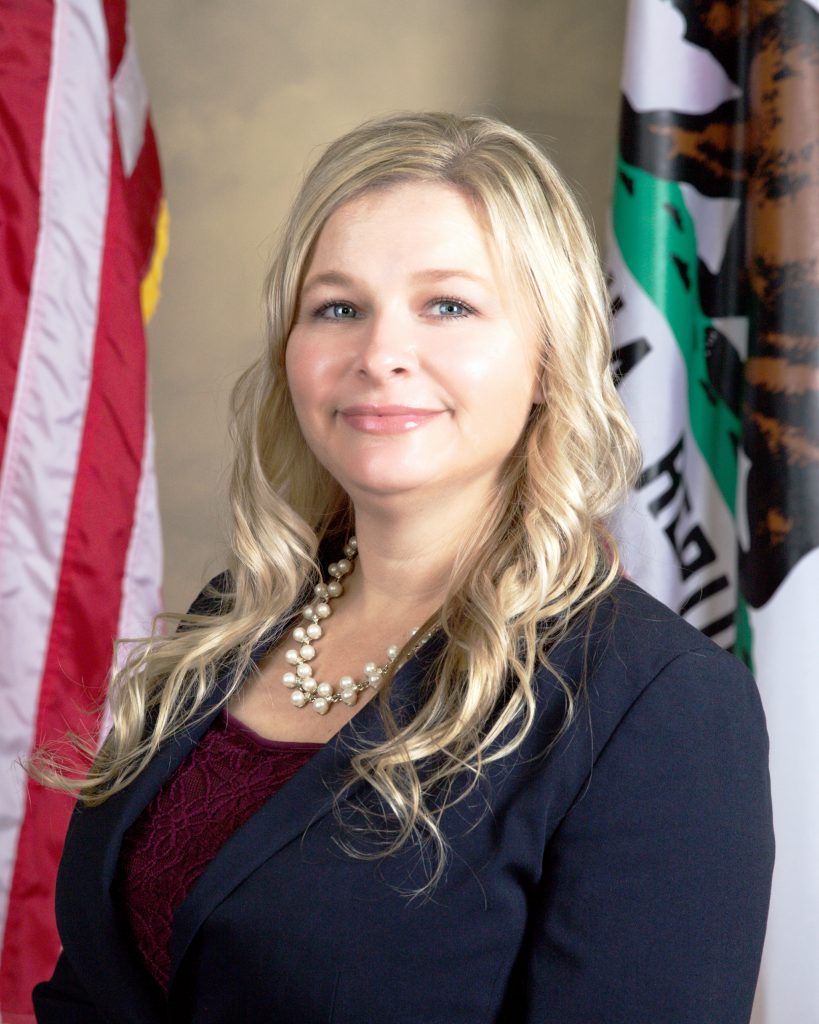
Heather Shirley was appointed Warden at Wasco State Prison-Reception Center (WSP-RC) in June 2022. She had served as acting warden since November 2020.
She began her career with CDCR in July 2000 and reported as a correctional officer to California Medical Facility in September 2000. She subsequently was promoted to correctional sergeant and correctional lieutenant.
In July 2010 she promoted to correctional captain at California State Prison-Solano, where she also held the positions of facility captain, and associate warden. As an associate warden, she transferred to CDCR, Division of Adult Institutions, in June 2015 where she remained until her appointment to chief deputy warden at WSP-RC in October 2016.

David Hill began his career with CCHCS/CDCR at Wasco State Prison in 2009. He has over 30 years of experience as a CEO in various hospitals and healthcare systems. Mr. Hill has been a lobbyist for the American Hospital Association and the Healthcare Association of Hawaii. He served on the Governor’s Advisory Panel for Healthcare and as Chairman of the Healthcare Association of Hawaii. He has worked with the federal government’s Tri-Care Program and Program 177 Bikini Atoll Survivor’s Program in the Marshall Islands. Mr. Hill assisted the government of Malaysia in building a network of private hospitals throughout the country and was associated with the Aga Khan Foundation. He maintains a private consulting firm with clients in Japan, South Korea and Thailand as well as in the United States.
Local Inmate Family Councils (IFC’s) are a gathering of family and friends of the incarcerated who meet regularly with Wardens to support visiting since keeping strong family connections with loved ones is a powerful rehabilitative tool. These IFC’s promote visiting by clarifying rules and regulations as well as discussing health, education, vocational training, packages, books, and related issues. For more information on connecting with a local IFC, please visit the Statewide IFC website .
- Election 2024
- Entertainment
- Newsletters
- Photography
- Personal Finance
- AP Investigations
- AP Buyline Personal Finance
- Press Releases
- Israel-Hamas War
- Russia-Ukraine War
- Global elections
- Asia Pacific
- Latin America
- Middle East
- Election Results
- Delegate Tracker
- AP & Elections
- March Madness
- AP Top 25 Poll
- Movie reviews
- Book reviews
- Personal finance
- Financial Markets
- Business Highlights
- Financial wellness
- Artificial Intelligence
- Social Media
Wall Street Journal reporter loses appeal and will stay in a Russian jail at least through November
FIle - Wall Street Journal reporter Evan Gershkovich stands in a glass cage in a courtroom at the Moscow City Court, in Moscow, Russia, Oct. 10, 2023. The Biden administration says its made a new and significant offer aimed at securing the release of American detainees Paul Whelan and Evan Gershkovich, but Russia has rejected the offer. (AP Photo/Alexander Zemlianichenko, File)
Wall Street Journal reporter Evan Gershkovich stands in a glass cage in a courtroom at the Moscow City Court in Moscow, Russia, Tuesday, Oct. 10, 2023. A Russian court on Tuesday is scheduled to hear a defense appeal of Wall Street Journal reporter Evan Gershkovich against the decision to extend his period of detention. (AP Photo/Alexander Zemlianichenko)
Wall Street Journal reporter Evan Gershkovich stands in a glass cage in a courtroom at the Moscow City Court, in Moscow Russia, Tuesday, Oct. 10, 2023. A Russian court on Tuesday is scheduled to hear a defense appeal of Wall Street Journal reporter Evan Gershkovich against the decision to extend his period of detention. (AP Photo/Alexander Zemlianichenko)
Wall Street Journal reporter Evan Gershkovich reacts standing in a glass cage in a courtroom at the Moscow City Court, in Moscow Russia, Tuesday, Oct. 10, 2023. A Russian court on Tuesday is scheduled to hear a defense appeal of Wall Street Journal reporter Evan Gershkovich against the decision to extend his period of detention. (AP Photo/Alexander Zemlianichenko)
Wall Street Journal reporter Evan Gershkovich smiles standing in a glass cage in a courtroom at the Moscow City Court, in Moscow Russia, Tuesday, Oct. 10, 2023. A Russian court on Tuesday is scheduled to hear a defense appeal of Wall Street Journal reporter Evan Gershkovich against the decision to extend his period of detention. (AP Photo/Alexander Zemlianichenko)
- Copy Link copied
MOSCOW (AP) — Wall Street Journal reporter Evan Gershkovich lost an appeal Tuesday to be released from jail on espionage charges, meaning he will remain behind bars at least through Nov. 30.
Gershkovich, 31, had a mostly blank expression as he appeared in the defendant’s glass cage in Moscow City Court in blue shirt, T-shirt and jeans. He marked six months in custody on Sept. 29.
It was the second time in less than a month he had appeared before a judge to appeal an August decision to extend his pre-trial detention through November. On Sept. 19, the court declined to hear the appeal, citing unspecified procedural violations.
The U.S. Embassy in Moscow said in a statement that it was “deeply disappointed” that Gershkovich’s appeal was rejected, adding: “Evan should be released.”
The journalist was detained in March while on a reporting trip to the city of Yekaterinburg, about 2,000 kilometers (1,200 miles) east of Moscow.
The court proceedings are closed because prosecutors say details of the criminal case are classified.
Russia’s Federal Security Service alleged Gershkovich, “acting on the instructions of the American side, collected information constituting a state secret about the activities of one of the enterprises of the Russian military-industrial complex.”
Gershkovich and the Journal deny the allegations, and the U.S. government has declared him to be wrongfully detained. Russian authorities haven’t detailed any evidence to support the espionage charges.
He is being held at Moscow’s Lefortovo prison, notorious for its harsh conditions. Gershkovich is the first American reporter to be charged with espionage in Russia since 1986, when Nicholas Daniloff, a Moscow correspondent for U.S. News and World Report, was arrested by the KGB.
Analysts have pointed out that Moscow may be using jailed Americans as bargaining chips after U.S.-Russian tensions soared when Russia sent troops into Ukraine. At least two U.S. citizens arrested in Russia in recent years — including WNBA star Brittney Griner — have been exchanged for Russians jailed in the U.S.
The Russian Foreign Ministry has said it will consider a swap for Gershkovich only after a verdict in his trial. In Russia, espionage trials can last for more than a year.

Brazilian Woman Arrested After Taking Dead Uncle to Bank to Secure Loan

Guess The Pro 49er Taking A Swim In This Studly Snap!

Tekashi 6ix9ine's Florida Home Hit By IRS Agents, Cars Seized

Check Out Woah Vicky's Adventures Bikini Snaps In Miami… Woah There!

Sydney Sweeney Fires Back on 'Not Pretty' Remark, Producer Regretful
El chapo missing wife & kids in prison, begs judge for visitation & calls, el chapo missin' wife & kids begs court for visitation, calls.
El Chapo 's life in lock-up is apparently getting lonely -- 'cause now he's asking a judge to let his wife visit him in prison ... and for his young daughters to be able to give him a ring.
The notorious Mexican cartel kingpin is begging a NYC court to authorize a family visit at the supermax United States Penitentiary Florence in Colorado -- where he's spending the rest of his life behind bars.
That's not all ... the ex-drug lord is also asking the court to continue allowing him 2 15-minute calls a month with his girls -- whom he got cut off from last May, which he suggests is the doing of the feds because he's trying to have his case tossed, and he believes they're retaliating.
Chapo writes of the prosecutor in his case, "She was surely upset because in the pro se motion, I exposed the inefficiency of the lawyers who did not fight the anomalies of the prosecutors throughout the process."
He adds, "And in response, they have decided to punish me by not letting me talk to my daughters. To this day they have not told me if they will no longer give me calls with my girls. That's why I'm bothering you, since you authorized those two calls a month. That is why I ask for your intervention, since it is unprecedented discrimination against me."
He goes on to say this is the only way to communicate with his kids, since they live in Mexico ... and can't visit him here in the States without a visa, which they don't currently have.
Chapo goes on to say the only person who could theoretically come and visit him in person would be his wife Emma Coronel -- and he's asking the court to give her the green light to do so. He doesn't mention a conjugal visit here ... but, well, y'know.
Funny enough ... Chapo signs this letter himself, and it sounds like he wrote it in his own words too. So, this clearly means a lot to him ... and he's writing in English to boot.
Emma herself was also behind bars for a bit -- that is, until she got released from prison last year ... and she's been living in L.A. ever since. You'll recall ... Emma hit the town and partied shortly after she was sprung.
As we reported ... El Chapo was found guilty back in 2019 for engaging in a continuing criminal enterprise, conspiracy to launder narcotics proceeds, international distribution of cocaine, heroin, marijuana, and other drugs, and use of firearms.
Of course, this came after the Sinaloa Cartel's leader was captured by the Mexican government in 2014 before famously escaping from jail cell more than a year later through a mile-long underground tunnel -- only to be caught again in early 2016.
The guy might be in prison for the rest of his days ... but he wants some company along the way -- and is hoping the court will throw him a lifeline in this regard.
- Share on Facebook
related articles

El Chapo's Wife Won't Get Extra Security in Jail After Drug Trafficking Bust

El Chapo's Wife Arrested for Drug Trafficking, Held Without Bond
Old news is old news be first.
- International

Iran attack on Israel

Mayorkas impeachment trial

Columbia president testifies
April 18, 2023 - Russia-Ukraine news
By Kathleen Magramo , Helen Regan , Jack Guy, Ed Upright, Aditi Sangal , Adrienne Vogt , Christina Maxouris, Tori B. Powell and Aya Elamroussi , CNN
Our live coverage for the day has ended. Follow the latest Ukraine news here or read through the updates below.
Russian foreign minister praises framework proposed by China and Brazil to end conflict in Ukraine
CNN’s Stefano Pozzebon in Bogota

Russian Foreign Minister Sergey Lavrov praised a framework introduced by China and Brazil, which proposed an end to the conflict in Ukraine.
“We applaud the position from China, and we have also held talks with Brazil on this, and these are very useful proposals because they can help to share ideas and help resolve problems,” Lavrov said Tuesday during a news conference in Caracas, Venezuela. “All this, however, is not part of the West’s rules.”
Lavrov explained the West would not accept the so-called “peace proposal” that would see the Crimean Peninsula fully integrated into the Russian Federation.
Meanwhile, Ukraine has repeatedly said peace in the conflict will only be achieved if Russia restores the country's borders and Kyiv takes back Crimea.
Since taking office this year , Brazilian President Luiz Inácio Lula da Silva has suggested his country could help broker a negotiation in the Russian invasion of Ukraine, arguing Kyiv should relinquish sovereignty claims over Crimea in exchange for the end of the conflict.
Last week, Lula traveled to China and both countries reiterated calls for a peaceful solution to the conflict.
Lula has largely adopted a policy of non-intervention over the war in Ukraine, following in the same footsteps of many leaders in middle-income and developing countries.
On Saturday, Lula said the US and the EU need to start talking about peace between Ukraine and Russia.
“The United States needs to stop encouraging war and start talking about peace; the European Union needs to start talking about peace so that we can convince Putin and Zelensky that peace is in the interest of everyone and that war is only interesting, for now, to the two of them,” Lula told reporters in Beijing on Saturday.
Some context: The US and EU have been major suppliers of arms and aid to Ukraine amid Russia’s invasion.
Lavrov is in Caracas as part of a five-day trip to Latin America, visiting Brazil, Venezuela, Cuba and Nicaragua. On Tuesday, Lavrov criticized US sanctions on Venezuela and said Russia intends to strengthen diplomatic and commercial relationships with the Andean country.
CNN's Tatiana Arias and Duarte Mendonca contributed reporting.
Detained WSJ journalist has a “very intimate view of Russian society,” bureau chief says

Ann Simmons, Wall Street Journal Moscow bureau chief, described detained journalist Evan Gershkovich as a “terrific reporter, largely because he is very familiar with Russian culture and history and tradition."
“He is from a Russian family, and his parents were Soviet immigrants to the United States. And so, he has got this very intimate view of Russian society," Simmons told CNN’s Anderson Cooper Tuesday night. “He's very passionate about Russia and Russians and the story in general. And being able to have that kind of intimate view is so powerful, especially when reporting from Russia," she said.
Some context: Gershkovich, a US citizen, was arrested in Russia last month on espionage charges. He is currently being held at the notorious Lefortovo prison in Moscow, where he’s expected to remain through at least May 29 and faces up to a 20-year-sentence.
The Wall Street Journal has vehemently denied the spying accusations against Gershkovich.
During a court hearing Tuesday, Gershkovich was denied an appeal to change the terms of his detention – a ruling the WSJ had expected, Simmons said.
“It was good to see a colleague despite the fact that we saw him in a glass box and in the courtroom essentially detained,” Simmons added.
Gershkovich’s attorneys are able to speak with him, and that’s how the newspaper has been gaining insight into his case. Gershkovich is in “good spirits right now,” she said, and has been watching culinary shows on TV while being held.
“We don't know much more than that,” she said. “Espionage cases are typically classified, and a lot of the information is not revealed.”
Russian activist arrested for "justifying terrorism" in death of pro-war blogger
From CNN’s Uliana Pavlova
A local Russian activist has been arrested after writing he didn’t “feel a shadow of sadness” about the death of Vladlen Tatarsky, a pro-war blogger who was killed in a bombing at an event in a St. Petersburg cafe this month.
Russian law enforcement authorities opened a criminal case against Yaroslav Shirshikov, accusing him of justifying terrorism, according to state news agency TASS.
In a Telegram post, Shirshikov wrote, in part, to "Tatarsky, who wanted to kill and rob everyone, as he liked, I wish glass wool lining his grave, as well as to those who voluntarily came to the creative evening of this scumbag in St. Petersburg."
Shirshikov was also one of the first people to publicly post on Telegram about Wall Street Journal journalist Evan Gershkovich’s arrest in Yekaterinburg last month. He told CNN earlier in a phone call that Gershkovich was looking into a number of stories and had texted him to say he was returning to the city. Shirshikov said they met up in Yekaterinburg before Gershkovich was arrested.
CNN has reached out to the WSJ for comment.
US will look at options to get WSJ reporter home, official says. Catch up on the latest
From CNN staff
The US will look at " creative and sometimes quite challenging options " to try and bring detained Wall Street Journal reporter Evan Gershkovich home, but the process could take a long time, a senior administration official told CNN Tuesday.
At a Tuesday court hearing in Moscow, Gershkovich was denied an appeal to change the terms of his detention.
Gershkovich, a US citizen, was arrested in Russia last month. He is being held in a pre-trial detention center at the notorious Lefortovo prison until at least May 29 and faces up to 20 years in prison on espionage charges. The Wall Street Journal has vehemently denied the spying accusations against him and the US State Department has officially designated him as wrongfully detained by Russia.
Here are the latest headlines:
- Leaked documents: The leaked Pentagon documents are not impacting the actions of NATO allies when it comes to Ukraine, NATO Secretary General Jens Stoltenberg told CNN Tuesday, adding some of the items leaked are "incorrect and manipulated." Western officials also told CNN during a Tuesday briefing the leaked documents have had no visible impact on the battlefield in Ukraine.
- US warns Russia: The US has sensitive nuclear technology at a nuclear power plant in Ukraine and has warned Russia not to touch it, according to a letter the US Department of Energy sent to Russia’s state-owned nuclear energy firm Rosatom last month. The letter comes as Russian forces continue to control the plant, which is the largest nuclear power station in Europe and sits in one part of a region Russia occupied after its invasion of Ukraine last February. The plant is still physically operated by Ukrainian staff, but Rosatom manages it.
- Russia's war equipment: Western officials say Russia is "going backwards" with the equipment it is using in Ukraine, and add that they've seen Moscow deploy tanks that were originally built after World War II while it struggles to replenish stocks of lost armored vehicles. The officials also said Russia was continuing to struggle with manpower, saying that despite being able to muster large numbers of personnel, Moscow was not providing them with adequate training.
- Biden extends ban on Russian-affiliated vessels: US President Joe Biden extended the ban on Russian-affiliated vessels from US ports, an order that was originally published last April and set to expire this week. Russia's policies and actions "continue the premeditated, unjustified, unprovoked, and brutal war against Ukraine," Biden wrote in a letter to Congress, explaining the extension.
Biden extends order blocking Russian-affiliated vessels from US ports
From CNN's DJ Judd

President Joe Biden extended the ban on Russian-affiliated vessels from US ports. The order, originally published last April, was originally set to expire this week.
“The policies and actions of the Government of the Russian Federation to continue the premeditated, unjustified, unprovoked, and brutal war against Ukraine continue to constitute a national emergency by reason of a disturbance or threatened disturbance of international relations of the United States,” Biden wrote in a letter to Congress. “Therefore, I have determined that it is necessary to continue the national emergency declared in Proclamation 10371.”
5 drones downed in Zaporizhzhia region, Ukrainian official says
From CNN's Victoria Butenko and Yulia Kesaieva
Five Shahed drones have been downed in the Zaporizhzhia region, according to Andriy Yermak, the head of Ukraine's president's office.
“Tonight, our Air Defense Forces performed masterfully in Zaporizhzhia,” Anatolii Kurtev, secretary of Zaporizhzhia City Council, said on Telegram.
The head of the Zaporizhzhia Regional Military Administration, Yurii Malashko, said that “enemy ‘tin cans’ have been successfully landed today.”
Russian who said he was a former Wagner fighter appears to recant claim that he killed civilians
From CNN's Tim Lister and Saskya Vandoorne

A Russian man who said he had killed children and other civilians while serving with the Wagner private military company in Ukraine appears to have recanted the claim, suggesting he was blackmailed into making it.
Azamat Uldarov, a former convict, made his retraction in a video call with the Russian news agency RIA-FAN. It’s unclear if there were any conditions to the interview.
He and another former convict, Alexey Savichev, previously gave long and rambling interviews to Russian human rights group Gulagu.net, saying they were among the tens of thousands of Wagner fighters recruited from Russian jails to fight in Ukraine.
Speaking with Gulagu founder Vladimir Osechkin , Uldarov said he shot and killed a young girl, calling it “a management decision.”
“I wasn’t allowed to let anyone out alive, because my command was to kill anything in my way,” he said, estimating that the girl was five or six years old.
In his interview with RIA-FAN – which is associated with Wagner Group leader Yevgeny Prigozhin – Uldarov said he was drunk when he gave the interview, and alleged that Osechkin had blackmailed him about his time in prison.
Asked by RIA-FAN: “They made you say what you said in the video, correct?” Uldarov replied: “Not only correct, it’s [expletive] correct. I had to say it because I had no choice.”
“I said whatever I was told to say,” Uldarov then said.
“Prigozhin is a great guy,” he added, giving a thumbs up. “He saved our lives.”
But Gulagu’s Osechkin, who is based in France, told CNN he stood by the content of his interviews with the two men, citing Uldarov’s retraction as proof of how quickly dissenting voices are silenced in Russia.
Osechkin also claimed that both interviewees, Uldarov and Savichev, had been threatened with murder if they didn’t retract their statements to him. Savichev told Gulagu that his unit was ordered to kill any men 15 years old or older.
Read more here
US "will look at creative and sometimes quite challenging options" to get Gershkovich home, official says
From CNN's Jennifer Hansler and Kylie Atwood
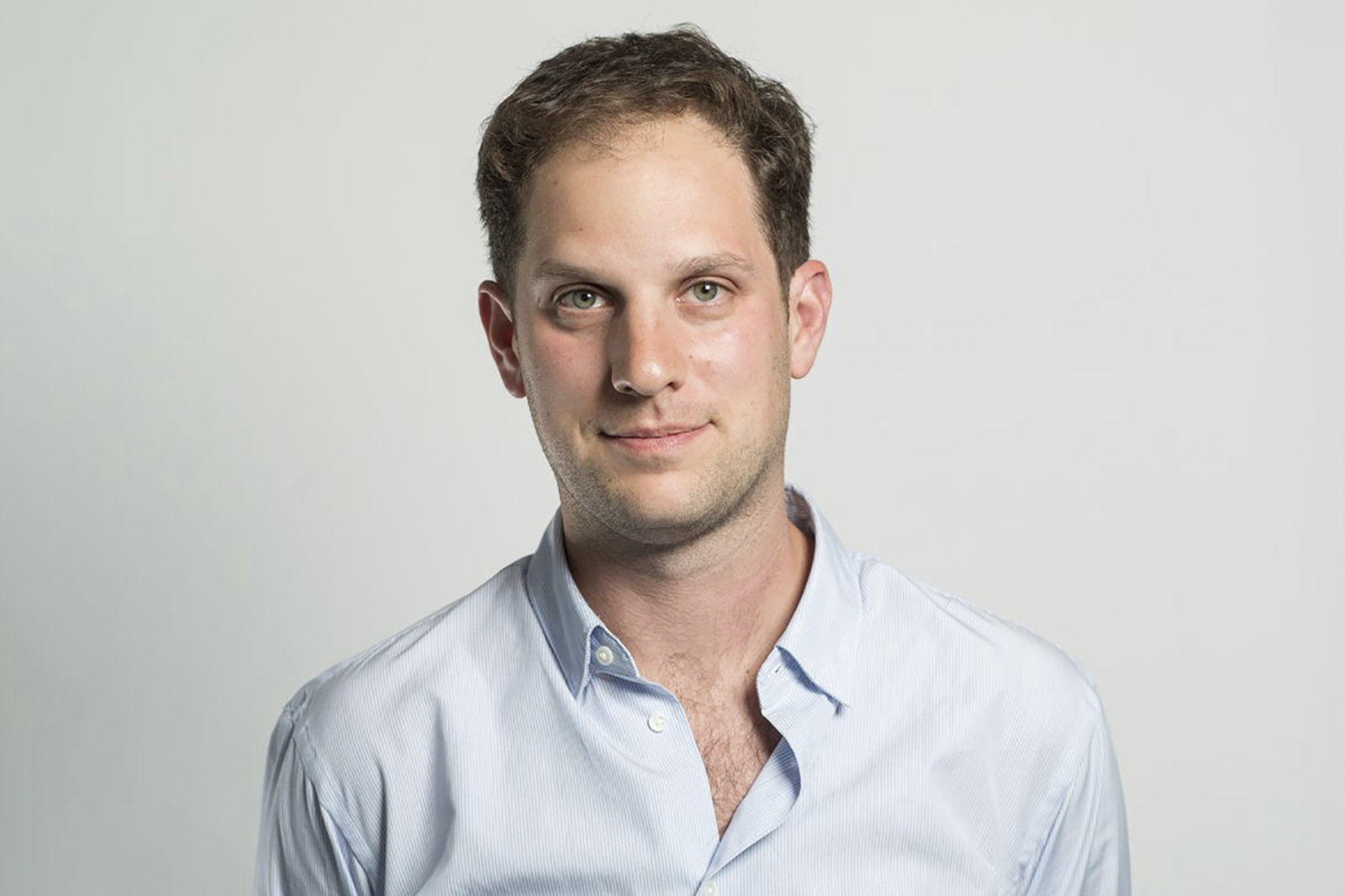
The United States “will look at creative and sometimes quite challenging options” to try to bring home detained Wall Street Journal reporter Evan Gershkovich , but the process could take a long time, a senior administration official told CNN on Tuesday.
The official declined to provide details on these options and also on whether any proposals have been discussed with Russia.
“Until an American is home, we're always exploring and re-exploring and re-exploring what the options might be available to bring that American home,” the official added.
In the past the Russians have wanted legal proceedings – which the US views as “illegitimate” — to play out in court first before they will engage in any serious negotiations, the official said, and the process may take a long time
On Tuesday, a Russian court denied Gershkovich’s appeal to serve out his pre-trial detention under house arrest rather than at the notorious Lefortovo Prison. He will be held there until at least May 29 and faces a prison sentence of up to 20 years on espionage charges that the US has strongly condemned.
Calling the lack of regular consular access for Gershkovich “appalling,” the senior administration official said that the US hasn’t heard “specific” concerns about the conditions of the US national's detention, but said that his detention writ large is “inhumane.”
The US State Department has officially designated Gershkovich as wrongfully detained by Russia. “I think the starting point for our position on this, including engaging with the Russians, but also for helping the world to understand what's happened, is that this just should never have been this way in the first place,” the official said, adding that officials are “still figuring out exactly where all of this goes” in terms of negotiations.
Last week, Special Presidential Envoy for Hostage Affairs Roger Carstens said that the Russians have not indicated what they would want in exchange for the release of Gershkovich.
Please enable JavaScript for a better experience.

IMAGES
VIDEO
COMMENTS
A conjugal visit is a scheduled period in which an inmate of a prison or jail is permitted to spend several hours or days in private with a visitor. The visitor is usually their legal spouse. The generally recognized basis for permitting such visits in modern times is to preserve family bonds and increase the chances of success for a prisoner's eventual return to ordinary life after release ...
In 1993, 17 states had conjugal visitation programs. By the 2000s, that number was down to six, with only California, Connecticut, Mississippi, New Mexico, New York, and Washington allowing such visits. And by 2015, Mississippi and New Mexico eliminated their programs. For the most part, states no longer refer to "conjugal" visits.
Conjugal visits began around 1918 at Parchman Farm, a labor camp in Mississippi. At first, the visits were for black prisoners only, and the visitors were local prostitutes, who arrived on Sundays and were paid to service both married and single inmates. According to historian David Oshinsky, Jim Crow-era prison officials believed African ...
Conjugal visits usually happen in a separate, designated building on the prison property. These areas are designed for comfort and privacy as the couple spends quality time together. While the setup is different for each prison, generally, the space has a bed or cot, a seating area, and a bathroom.
Conjugal visits, the editors of The Bridge wrote, are "a controversial issue, now quite in the spotlight," thanks to their implementation at Parchman Farm in Mississippi in 1965. But the urgency of the mens' plea, as chronicled in The Bridge and the Somers Weekly Scene, gives voice to the depth of their deprivation.
Conjugal visits originated in Mississippi at the infamous prison plantation, Mississippi State Penitentiary, or Parchman Farm. Mississippi state officials opened Parchman in the early 1900s, writes historian David Oshinsky in his book Worse than Slavery: Parchman Farm and the Ordeal of Jim Crow Justice, in order to ensnare free Black people ...
In the eyes of the law, conjugal visits are a privilege, not a right. The Supreme Court has repeatedly upheld prison administrators' latitude to limit prisoners' rights, including visitation ...
The three before-and-after study of partnership qualities suggested benefit, but conjugal visiting was within a wider family-support programme. Studies with in-prison behaviour as a possible outcome suggest small, if any, association, although one US-wide study found significantly fewer in-prison sexual assaults in states allowing conjugal ...
Only some countries permit private conjugal visits in prison between a prisoner and community living partner. Aims: Our aim was to find evidence from published international literature on the safety, benefits or harms of such visits. Methods: A systematic literature review was conducted using broad search terms, including words like 'private ...
Abstract. Background Imprisonment impacts on lives beyond the prisoner's. In particular, family and intimate relationships are affected. Only some countries permit private conjugal visits in ...
Conjugal visits help inmates maintain strong ties with loved ones, even while in prison. Conjugal visits help inmates maintain strong ties with families and loved ones, even while in prison. While the scheme looks promising, surprisingly, only four states in the United States still practice it.
This article examines the impact of conjugal visits on sexual violence in prisons by examining longitudinal data from all fifty states. In this study the dependent variable is the yearly number of reported sexual offenses between incarcerated persons and the independent variable of interest is a dummy variable based on if a state has a conjugal ...
Conjugal visits are usually only allowed in medium security or lower prisons, and are now allowed for prisoners convicted of sexual assaults. But each state has its own rules: Only New York and California, for example, allow same-sex conjugal visits. And in Connecticut, according to Thrillist, a spouse or partner is required to visit with the ...
The FIU study was conducted over a three-year period. from 2004 to 2006, in the states that allowed prisoners conjugal visits at the lime: California, Mississippi, New Mexico, New York and Washington. While sexual violence occurred in states that prohibit conjugal visits at a rate of 226 per 100,000 prisoners, it occurred nearly five times less ...
General Visiting Information. Make sure your visit will be a success by carefully following these four steps. Locate the inmate. Discover or confirm the whereabouts of the inmate you would like to visit. Be Approved. Before you can visit you must be placed on the inmate's approved visiting list. Be Prepared.
1979. Length. 28 pages. Annotation. CASE LAW, INSTITUTIONAL PROGRAMS, PUBLIC OPINION, AND THE U.S. CONSTITUTION ARE ALL INVOKED IN THE FIGHT FOR PRISONERS' RIGHT TO HAVE CONJUGAL VISITS. Abstract. STUDIES ILLUSTRATE THE SEVERE IMPACT PROLONGED DEPRIVATION OF INTIMATE AND SEXUAL CONTACT CAN HAVE ON THE PERSONALITY STRUCTURE OF THE INMATE ...
Following this official sanction, instead of just tolerating conjugal visiting, the prison staff began to support it. It was the Federal court order (Gates v. Collier) in January of 1971 that stroke the final nail since it ordered a lot of changes at Parchman prison facilities amongst them a general revamping of outdated inmate housing which ...
Conjugal visits were designed as a means to preserve families and give incarcerated people the opportunity to procreate even while in prison. These days, there are not many prison facilities around the world that still allow conjugal visits from an inmate's registered spouse.
Answer: (1) The prison doesn't have special conjugal rooms. They're just little plywood cubicles with one bare light bulb in the ceiling and a metal cot with a thin mattress. The visiting area is in the basement in a space that used to be used for storage. It's divided into 28 cubicles.
But those who choose to visit through a remote device are charged a fee. Prices differ based on what company the jail contracts with. For example, remote visits with jails that use Securus range ...
Israeli prison authorities are refusing to return the body of author and activist Walid Daqqa to his family following his death in detention on 7 April. ... Israeli prison authorities denied the couple conjugal visits despite their prolonged struggle for the right. The couple resorted to conceiving through smuggled sperm, ultimately welcoming a ...
Natalee Holloway's killer reportedly attacked by 2 men in Peru prison last week. ... he is granted conjugal visits there with multiple women for his mental health and rehabilitation under the ...
Wasco State Prison‑Reception Center (WSP) Main Phone: (661) 758-8400. Physical Address: 701 Scofield Avenue, Wasco, CA 93280 ... (IFC's) are a gathering of family and friends of the incarcerated who meet regularly with Wardens to support visiting since keeping strong family connections with loved ones is a powerful rehabilitative tool ...
Wall Street Journal reporter Evan Gershkovich, who has been detained in Russia on espionage charges, has lost an appeal to be released from jail, meaning he will stay behind bars at least until Nov. 30.
742. 4/10/2024 1:17 PM PT. Getty. El Chapo 's life in lock-up is apparently getting lonely -- 'cause now he's asking a judge to let his wife visit him in prison ... and for his young daughters to ...
Putin asked for situation update during visit to troops in Russian-occupied Kherson, Kremlin says ... The Moscow City Court on Monday sentenced Kara-Murza to 25 years in prison in the case of ...